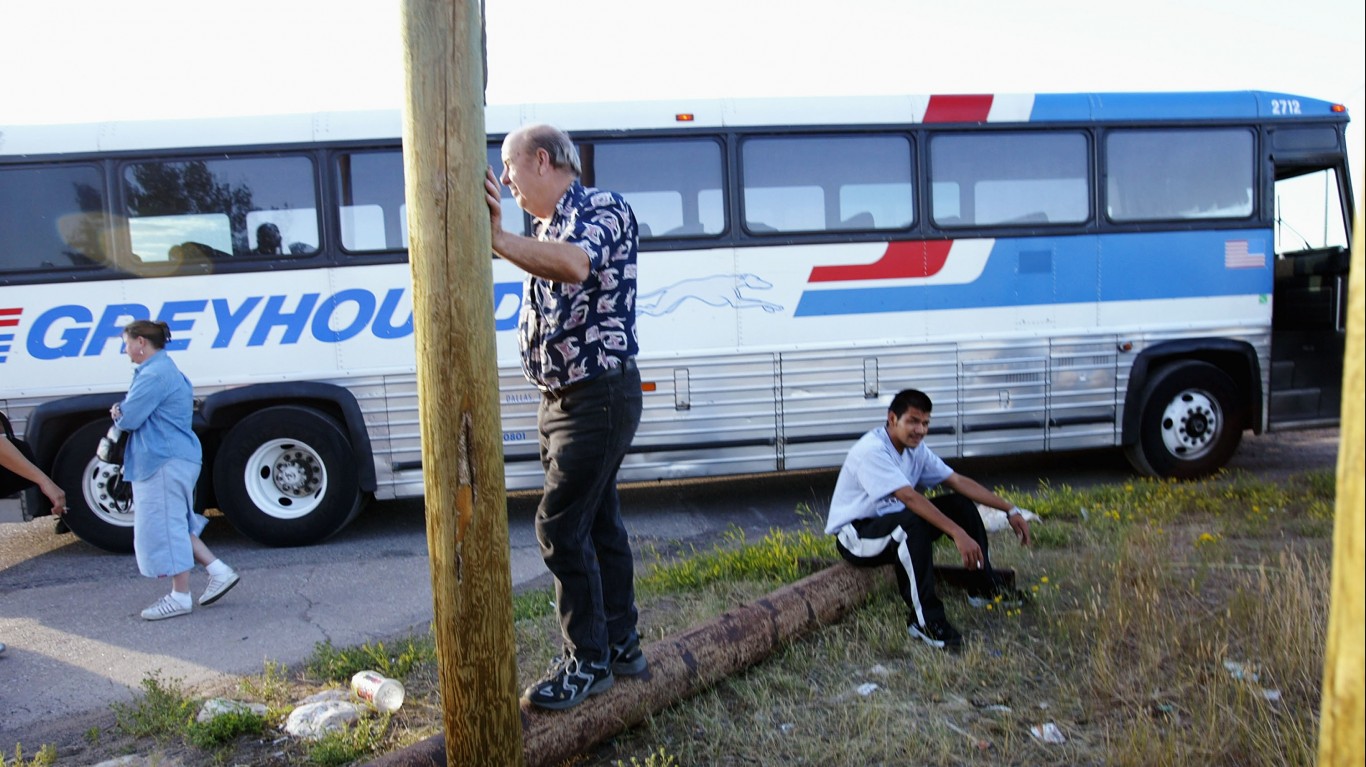

Compared to the rest of the world, the United States has a relatively high standard of living. However, in a country home to over 328 million people spanning nearly 3.8 million square miles, there are outliers — places where quality of life has been eroded by any number of economic and historical forces.
While there are countless factors — many of them subjective — that can contribute to or detract from quality of life, there are a few key objective measures that can reveal a great deal about a given area. The United Nations Development Programme identified some of these measures and created the Human Development Index, a tool to gauge and compare prosperity at a national level from a holistic perspective.
Inspired by the HDI, 24/7 Wall St. created an index of three measures — poverty, life expectancy at birth, and bachelor’s degree attainment — to identify the worst U.S. counties to live in.
The three measures used to create this list are closely related to each other. People living in poverty are often less able to afford health care or healthy lifestyles, both of which can have serious health repercussions. Similarly, higher educational attainment has been shown to improve health outcomes and reduce the likelihood of unemployment and financial hardship. Both high poverty rates and low educational attainment rates are common in parts of the U.S. with low life expectancy at birth.
Many of the counties on this list are in rural Appalachian coal country — an area that has been economically decimated by the decline of coal mining in the United States. Once an economic pillar in communities across West Virginia and Kentucky, coal production has precipitously declined in these areas as the U.S. power grid moves away from coal and relies more on cleaner burning natural gas and renewable energy sources. Here is a look at how much renewable energy your state produces.
Most of the remaining counties on this list are located in or around American Indian reservations. Native Americans commonly face generational poverty resulting, in part, from their historical mistreatment by the U.S. government. Certain existing conditions in some reservations also affect upward economic mobility. For example, reservation land is often communally-owned, making it difficult for local residents to build wealth through homeownership. Here is a look at the states with the most Indian reservations and tribal areas.
Click here to see the worst counties to live in.
Click here to see our methodology.
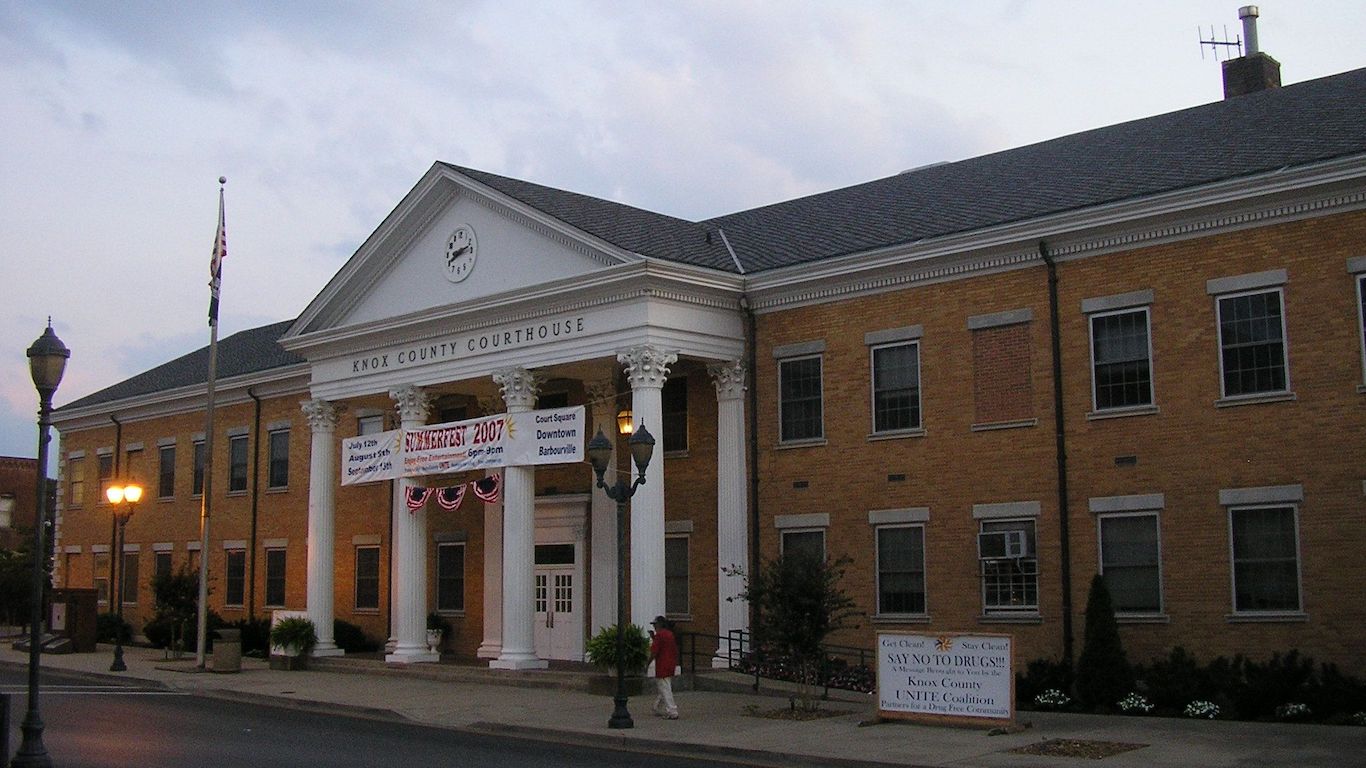
50. Knox County, Kentucky
> Poverty rate: 33.2%
> Adults with a bachelor’s degree: 14.2%
> Life expectancy at birth: 72.5 years
> Total population: 31,365
> Largest place in county: Corbin
With a low average life expectancy at birth and a high poverty rate, Knox County, Kentucky, ranks among the worst places to live in the United States. At 72.5 years, average life expectancy in Knox County is over six years below the national average. As is often the case in areas with poor health outcomes, Knox County is poor. Nearly one-third of its 31,000 residents live below the poverty line.
The county, located in the southeastern part of the state, is one of many with similar socioeconomic conditions where coal mining was once an economic pillar. Coal use is on the decline in the United States, however, as cleaner burning natural gas gained favor, and places like Knox County are feeling the impact.
[in-text-ad]
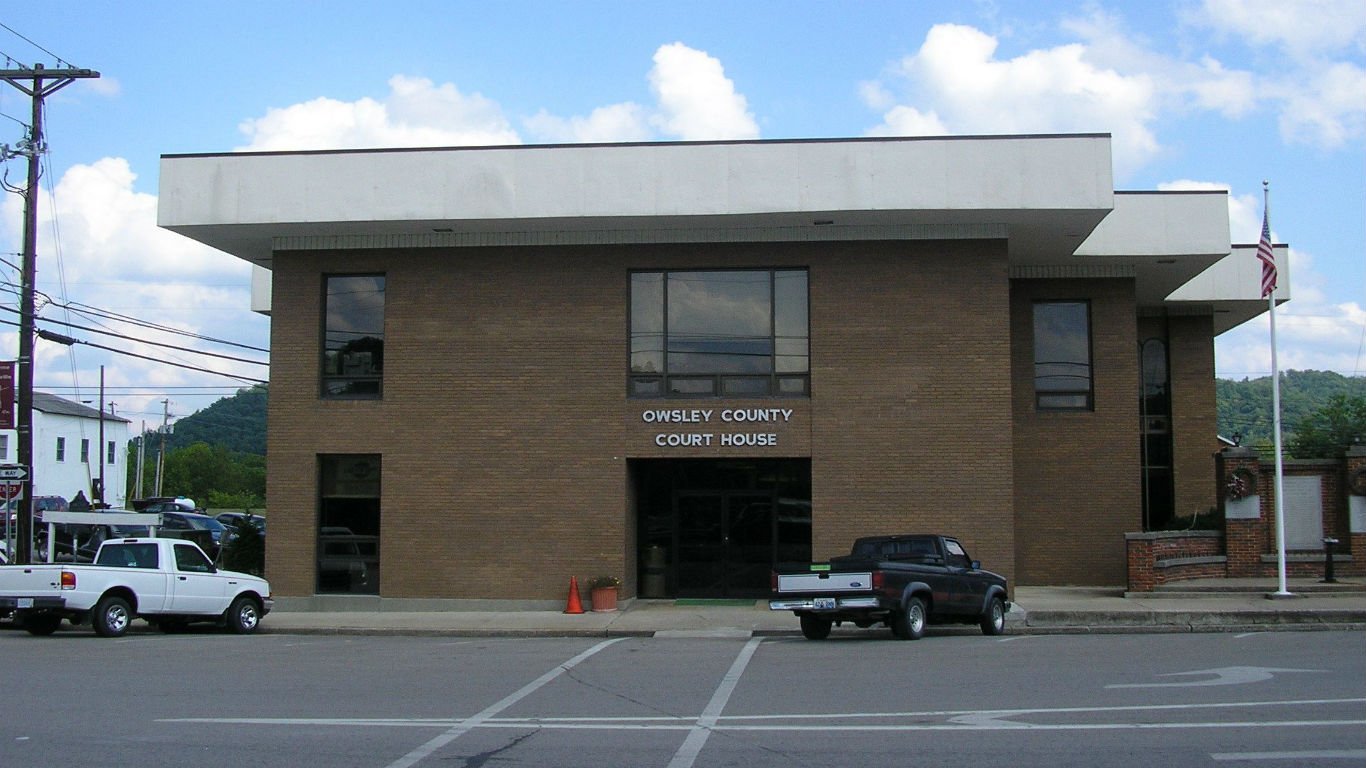
49. Owsley County, Kentucky
> Poverty rate: 30.3%
> Adults with a bachelor’s degree: 16.2%
> Life expectancy at birth: 69.0 years
> Total population: 4,442
> Largest place in county: Booneville
Owsley County, Kentucky, which includes the city of Booneville, ranks as one of the worst places to live in the United States, largely because of poor health outcomes. Life expectancy at birth in the county is just 69 years, about 10 years below the national average. Americans living below the poverty line are more likely to report poor health outcomes — and in Owsley County, over 30% residents do.
The local poverty rate would likely decline with an improved job market. As of January 2021, 7.4% of the area’s labor force were unemployed. Even before the COVID-19 pandemic, the local 2019 unemployment rate stood at 7.0%, well above the comparable 3.7% national rate.

48. Dewey County, South Dakota
> Poverty rate: 31.3%
> Adults with a bachelor’s degree: 16.6%
> Life expectancy at birth: 69.6 years
> Total population: 5,833
> Largest place in county: North Eagle Butte
Dewey County, South Dakota, which lies within the Cheyenne River Indian Reservation, ranks as one of the worst places to live in the United States. For a variety of historical and contemporary reasons, Native American populations are among the most disadvantaged groups in the United States. In Dewey County, over 31% of the population live below the poverty line, and the average life expectancy at birth is less than 70 years.
Adults in Dewey County are also far less likely to have the benefits of a four-year college education, such as access to higher-paying jobs. Just 16.6% of the 25 and older population have a bachelor’s degree, about half the comparable share of adults nationwide.

47. Hancock County, Tennessee
> Poverty rate: 28.6%
> Adults with a bachelor’s degree: 11.2%
> Life expectancy at birth: 70.3 years
> Total population: 6,587
> Largest place in county: Sneedville
Hancock County, Tennessee, located in the northeastern part of the state, ranks as one of the worst places to live in the United States. Only 11.2% of adults in the county have a bachelor’s degree, about one-third the national rate. Educational attainment can have a meaningful impact on health outcomes through often higher incomes, and better access to health care and healthier lifestyle. At 70.3 years, life expectancy at birth in Hancock County is nearly nine years below the national average.
Unhealthy and unsafe behaviors are partially to blame for the low life expectancy in the area. Smoking is the leading cause of preventable death in the United States, and over 25% of county adults smoke, one of the largest shares of any U.S. county. Additionally, two-thirds of all driving deaths in the county involve alcohol, more than double the comparable national share.
[in-text-ad-2]
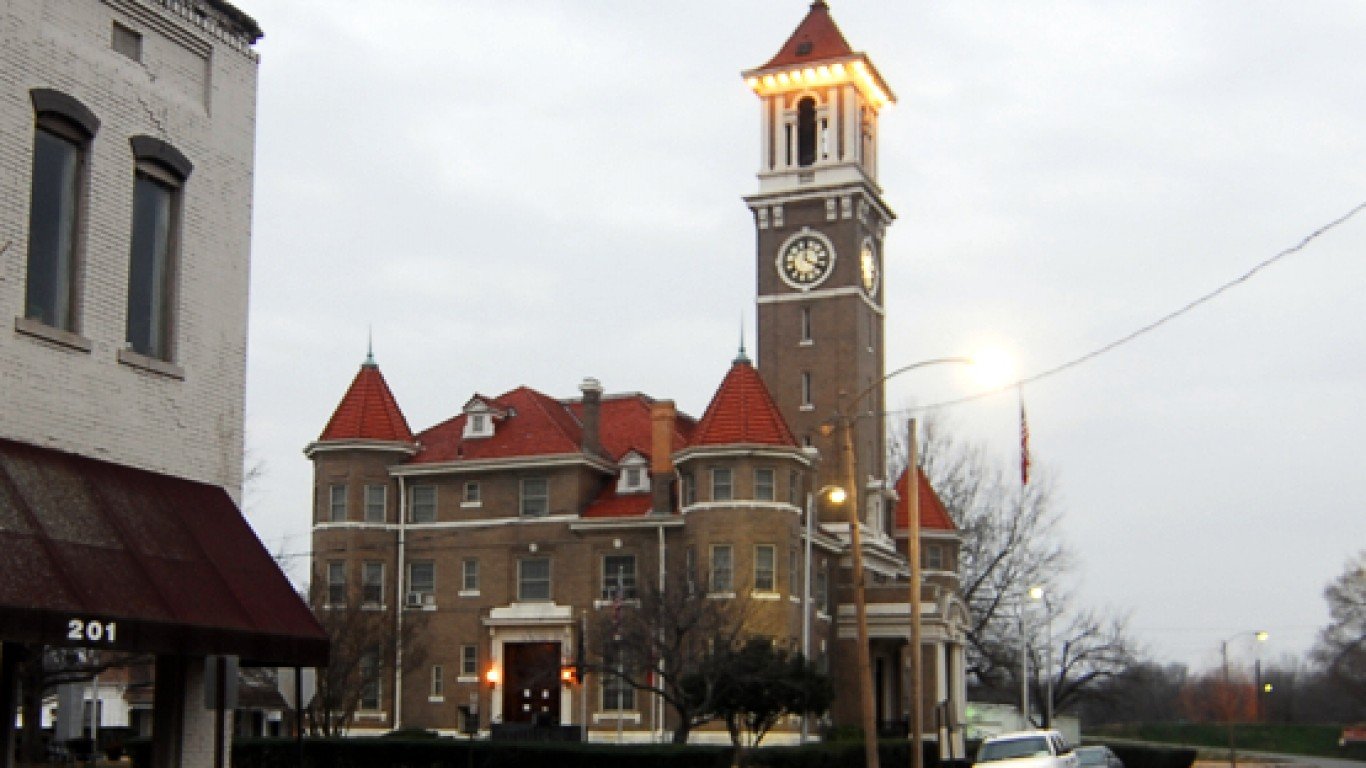
46. Monroe County, Arkansas
> Poverty rate: 27.1%
> Adults with a bachelor’s degree: 12.7%
> Life expectancy at birth: 68.2 years
> Total population: 7,050
> Largest place in county: Brinkley
Monroe County, located in east-central Arkansas, is one of the worst places to live in the country due in large part to poor health outcomes. Life expectancy at birth in Monroe County is just 68.2 years, over a decade below the national average. This is due in part to certain unhealthy behaviors, as the typical adult in the county is far less likely to exercise and far more likely to smoke than the typical American adult.
Low rates of physical activity among county residents may be due in part to limited access to places for exercise. Just 57% of area residents have adequate access to places like parks and recreation centers, compared to 84% of Americans nationwide.
45. Tensas Parish, Louisiana
> Poverty rate: 34.7%
> Adults with a bachelor’s degree: 11.4%
> Life expectancy at birth: 75.1 years
> Total population: 4,561
> Largest place in parish: Newellton
Economic conditions in Tensas Parish, Louisiana, make it one of the worst places to live in the United States. The poverty rate in the parish, located in the northeastern part of the state along the Mississippi River, stands at 34.7%, above the vast majority of U.S. counties and well more than double the 13.4% national poverty rate. The local poverty rate would likely decline if the job market improved. As of January 2021, 7.4% of the area’s labor force were unemployed. Even before the COVID-19 pandemic, the local 2019 unemployment rate stood at 8.3%, well above the comparable 3.7% national rate.
Poverty can have a marked impact on health outcomes. Life expectancy at birth in Tensas Parish is just 75.1 years, about four years below the national average.
[in-text-ad]

44. Mingo County, West Virginia
> Poverty rate: 28.7%
> Adults with a bachelor’s degree: 9.9%
> Life expectancy at birth: 71.0 years
> Total population: 24,290
> Largest place in county: Williamson
In Mingo County, located in southwestern West Virginia, fewer than one in every 10 adults have a bachelor’s degree, less than one-third of the comparable share nationwide. Incomes tend to rise with educational attainment, and nearly 29% of the more than 24,000 people in the county live below the poverty line.
Mingo County has been hit especially hard by social and economic problems much of the country is currently grappling with. Unemployment in the area stands at 11.2%, and few places have been affected more than Mingo County by the opioid crisis. There are an average of 64 drug overdose deaths in the county for every 100,000 people annually, more than triple the national rate.

43. Turner County, Georgia
> Poverty rate: 33.6%
> Adults with a bachelor’s degree: 11.7%
> Life expectancy at birth: 73.7 years
> Total population: 7,943
> Largest place in county: Ashburn
Turner County, located in south-central Georgia, is one of the poorest places in the United States. Over one-third of the local population live below the poverty line, and 18.4% of households in the county earn less than $10,000 a year, more than triple the national share. The county also ranks as one of the worst places to live also because of the relatively low life expectancy at birth. At just 73.7 years, it is over five years below the national average.
The county’s poor health outcomes are partially attributable to financial insecurity as well as unhealthy behaviors. An estimated 40% of local adults in the county are physically inactive, compared to 23% of adults nationwide. Low rates of physical activity among county residents may be due in part due to limited access to places for exercise. Just 20% of area residents have adequate access to places like parks and recreation centers, compared to 84% of Americans nationwide.

42. Wolfe County, Kentucky
> Poverty rate: 29.2%
> Adults with a bachelor’s degree: 8.7%
> Life expectancy at birth: 71.5 years
> Total population: 7,207
> Largest place in county: Campton
Wolfe County, located in eastern Kentucky, is one of several counties in the state to rank among the worst places to live in the United States. Nearly 30% of the local population live below the poverty line, and at just 71.5 years, life expectancy at birth in the county is among the lowest nationwide.
Located in the state’s eastern coal field region, Wolfe County’s economic fortunes have been tied in large part to the U.S. coal industry, which has long been in decline. As recently as 2012, the county produced nearly 40,000 tons of coal. As of 2020, there was no active coal production in the county.
[in-text-ad-2]
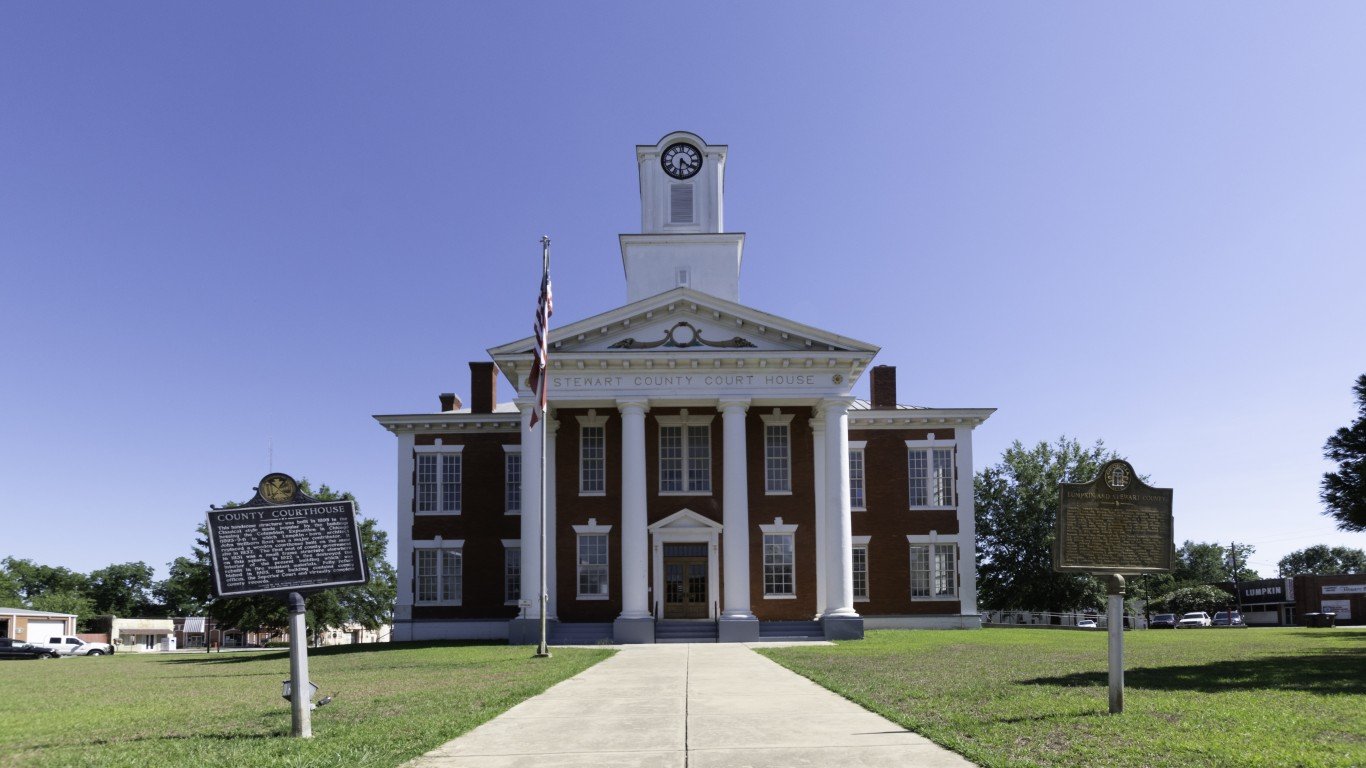
41. Stewart County, Georgia
> Poverty rate: 34.5%
> Adults with a bachelor’s degree: 12.2%
> Life expectancy at birth: 73.8 years
> Total population: 6,293
> Largest place in county: Richland
Stewart County, Georgia, located in the southwestern part of the state along the Alabama border, is one of the worst places to live in the United States largely because of its high poverty rate. Nearly 35% of the 6,300 people in the county live below the poverty line, compared to the 13.4% national poverty rate. Poverty and financial insecurity can take a toll on health outcomes, and life expectancy at birth in the county is just 73.8 years, over five years below the national average.
Both incomes and life expectancy tend to rise with educational attainment, and in Stewart County, only 12.2% of adults have a bachelor’s degree, compared to 32.1% of adults nationwide.
40. Dillon County, South Carolina
> Poverty rate: 32.6%
> Adults with a bachelor’s degree: 11.1%
> Life expectancy at birth: 72.7 years
> Total population: 30,689
> Largest place in county: Dillon
Dillon County, located in northeastern South Carolina, is the only county in the state to rank among the worst places to live in the United States. One of the least healthy counties in the country, life expectancy at birth in Dillon County is just 72.7 years, about six years below the national average.
The low life expectancy is due in part to the prevalence of certain unhealthy behaviors. For example, adults in Dillon County are more likely to smoke and less likely to exercise than the typical American adult. Widespread poverty may also be a factor. Nearly 33% of the local population live below the poverty line, well more than double the 13.4% national poverty rate.
[in-text-ad]
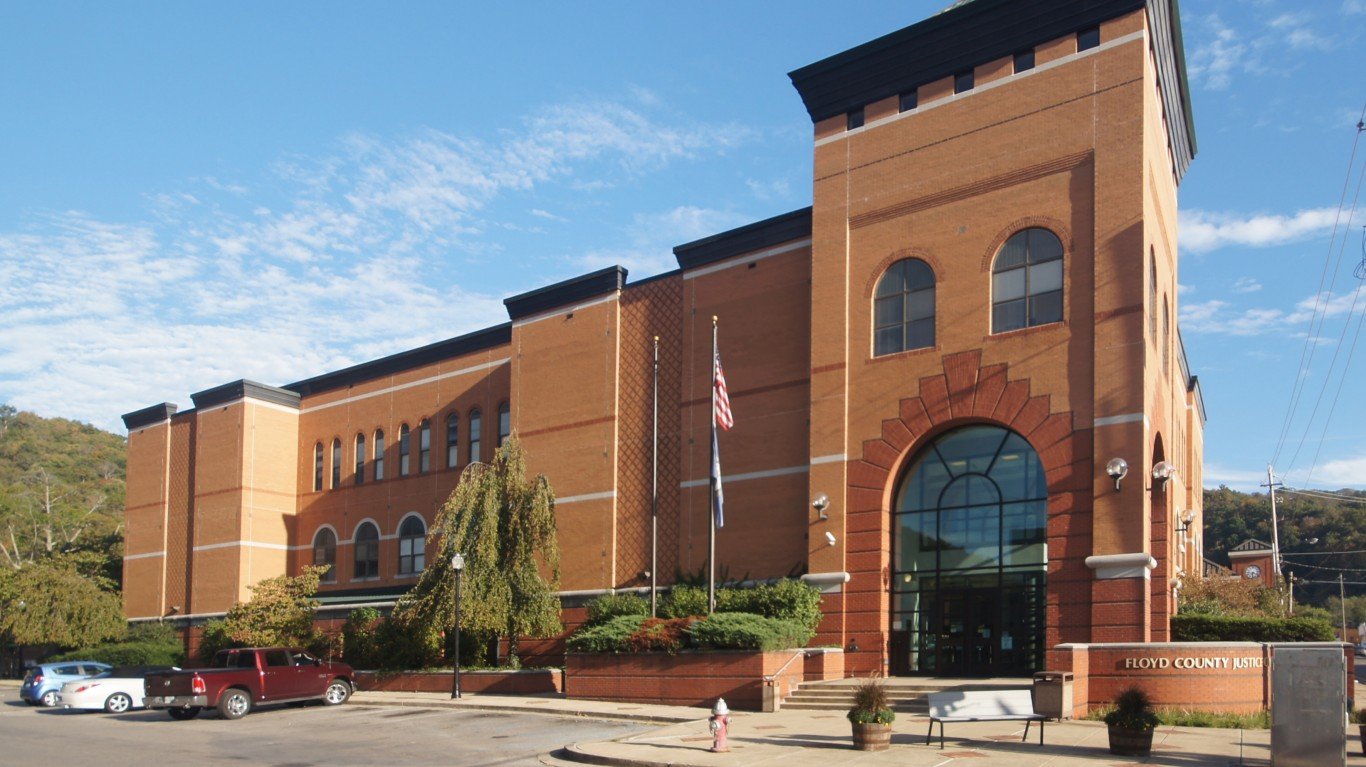
39. Floyd County, Kentucky
> Poverty rate: 30.7%
> Adults with a bachelor’s degree: 11.3%
> Life expectancy at birth: 71.0 years
> Total population: 36,456
> Largest place in county: Prestonsburg
Floyd County, located in eastern Kentucky, is one of the worst places to live in the United States. Coal extraction has long been an economic pillar in the county, and as U.S. energy production has shifted away from coal, places in eastern Kentucky and other parts of Appalachia have suffered economically. In Floyd County, 30.7% of the population live below the poverty line, and most households earn less than $33,000 annually.
As coal mining was a way many could earn a living without a college education, relatively few in Floyd County have the education necessary for many high paying jobs more common today. Just 11.3% of the local 25 and older population have a bachelor’s degree, about one-third the comparable share of adults nationwide.
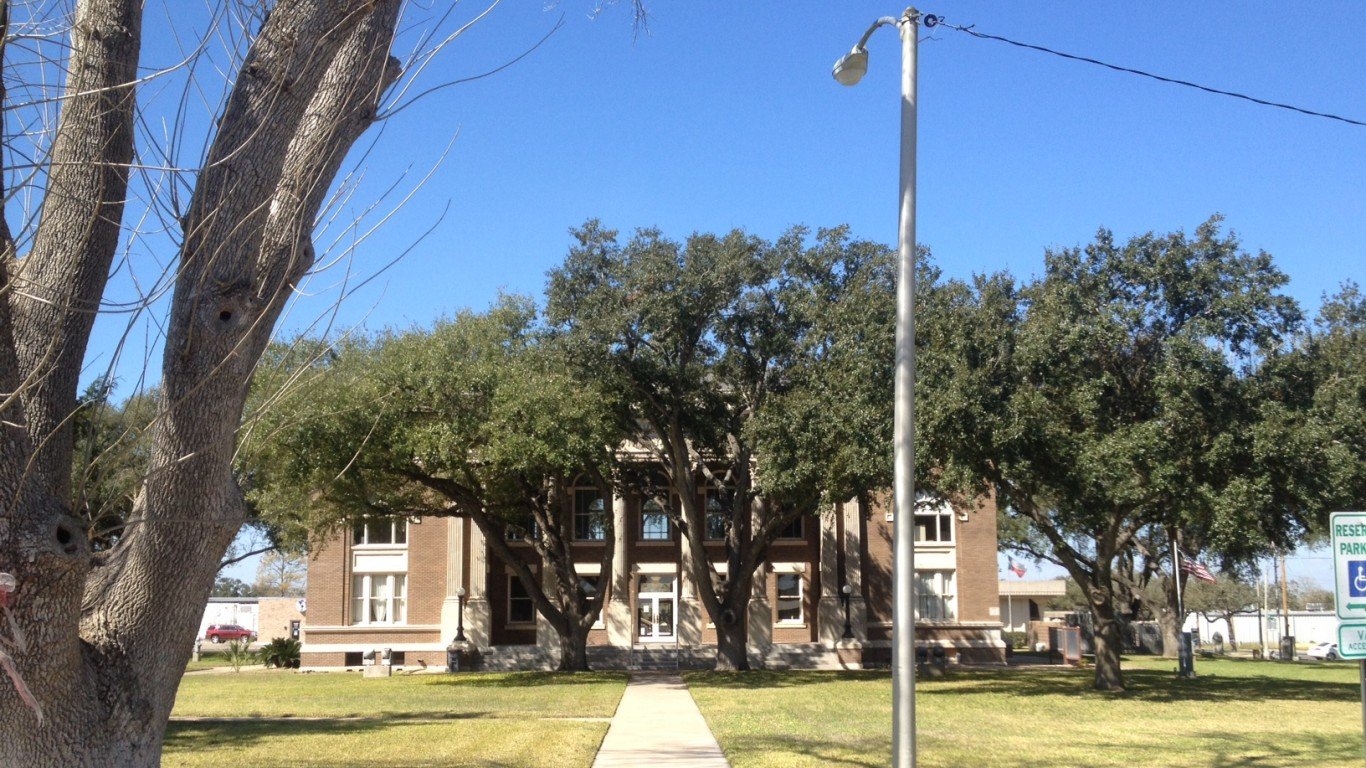
38. Brooks County, Texas
> Poverty rate: 41.4%
> Adults with a bachelor’s degree: 15.7%
> Life expectancy at birth: 77.1 years
> Total population: 7,141
> Largest place in county: Falfurrias
Brooks County, located in southern Texas, is the only county in the state to rank among the worst places to live in the United States. The county’s poverty rate of 41.4% is more than three times higher than the national poverty rate and among the 10 highest of all U.S. counties and county equivalents. Widespread poverty is due in part to a lack of economic opportunity. The unemployment rate in the county stands at 11.9%.
In recent years, Brooks County has been a popular crossing point for illegal migrants from Central America. Temperatures in the county regularly exceed 100 degrees Fahrenheit, making the journey especially dangerous for migrants, who often resort to breaking and entering and burglary out of necessity. The area is also used by drug traffickers from south of the border.

37. Claiborne County, Mississippi
> Poverty rate: 41.0%
> Adults with a bachelor’s degree: 24.0%
> Life expectancy at birth: 72.1 years
> Total population: 9,089
> Largest place in county: Port Gibson
Claiborne County, located in southwestern Mississippi, is one of several counties in the state to rank among the worst places to live nationwide. In Claiborne, quality of life is undermined by widespread poverty. The local poverty rate stands at 41%, more than triple the national poverty rate and among the 10 highest of all counties and county equivalents in the United States.
The local poverty rate would likely decline if the job market improved. As of January 2021, 13.5% of the area’s labor force were unemployed. Even before the COVID-19 pandemic, the local 2019 unemployment rate stood at 10.7%, well above the comparable 3.7% national rate.
[in-text-ad-2]
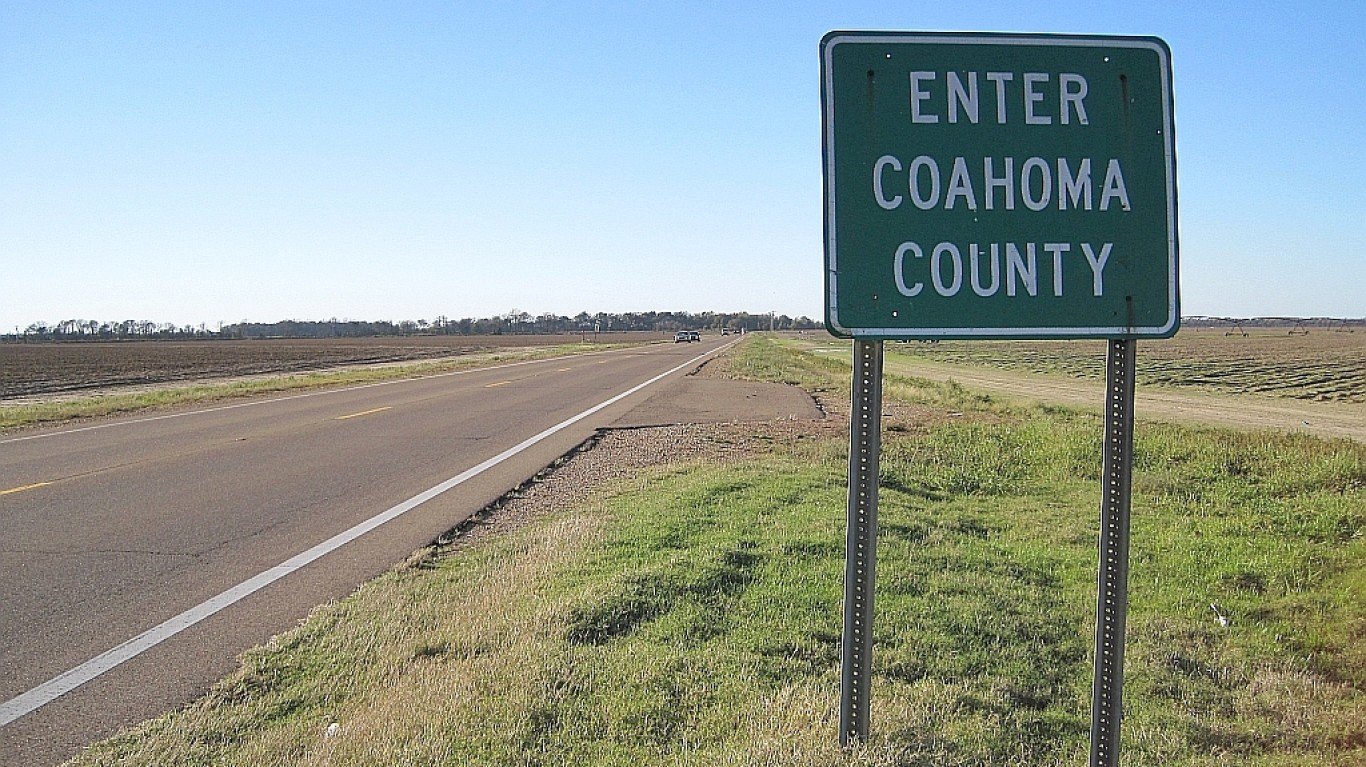
36. Coahoma County, Mississippi
> Poverty rate: 34.8%
> Adults with a bachelor’s degree: 16.5%
> Life expectancy at birth: 71.2 years
> Total population: 23,255
> Largest place in county: Clarksdale
Coahoma County, located in Mississippi’s Delta region, is one of the worst places to live in the country largely because of widespread poverty. Over a third of the area’s 23,300 residents live below the poverty line, and nearly 18% of households earn less than $10,000 a year, about three times the 6% share of all U.S. households living on so little.
Limited job availability partially explains the widespread poverty in Coahoma County. As of January 2021, 11.0% of the area’s labor force were unemployed. Even before the COVID-19 pandemic, the local 2019 unemployment rate stood at 7.7%, well above the comparable 3.7% national rate.

35. Menominee County, Wisconsin
> Poverty rate: 35.3%
> Adults with a bachelor’s degree: 17.9%
> Life expectancy at birth: 70.6 years
> Total population: 4,558
> Largest place in county: Keshena
Many of the counties with some of the worst socioeconomic conditions and public health outcomes in the United States are located on Native American reservations, and Menominee County, Wisconsin, which shares a boundary with the Menominee Indian Reservation, is one of them. At 70.6 years, average life expectancy at birth in the county is over eight years below the national average.
The county’s low life expectancy is likely due to several behavioral and economic factors. Smoking is the leading cause of preventable death in the United States, and obesity is a risk factor for many potentially life threatening diseases and conditions — and adults in Menominee County are far more likely than most Americans to smoke or be obese. Poverty can also make it difficult to access health care and maintain healthy lifestyles, and over one-third of the 4,600 people in the county live below the poverty line.
[in-text-ad]
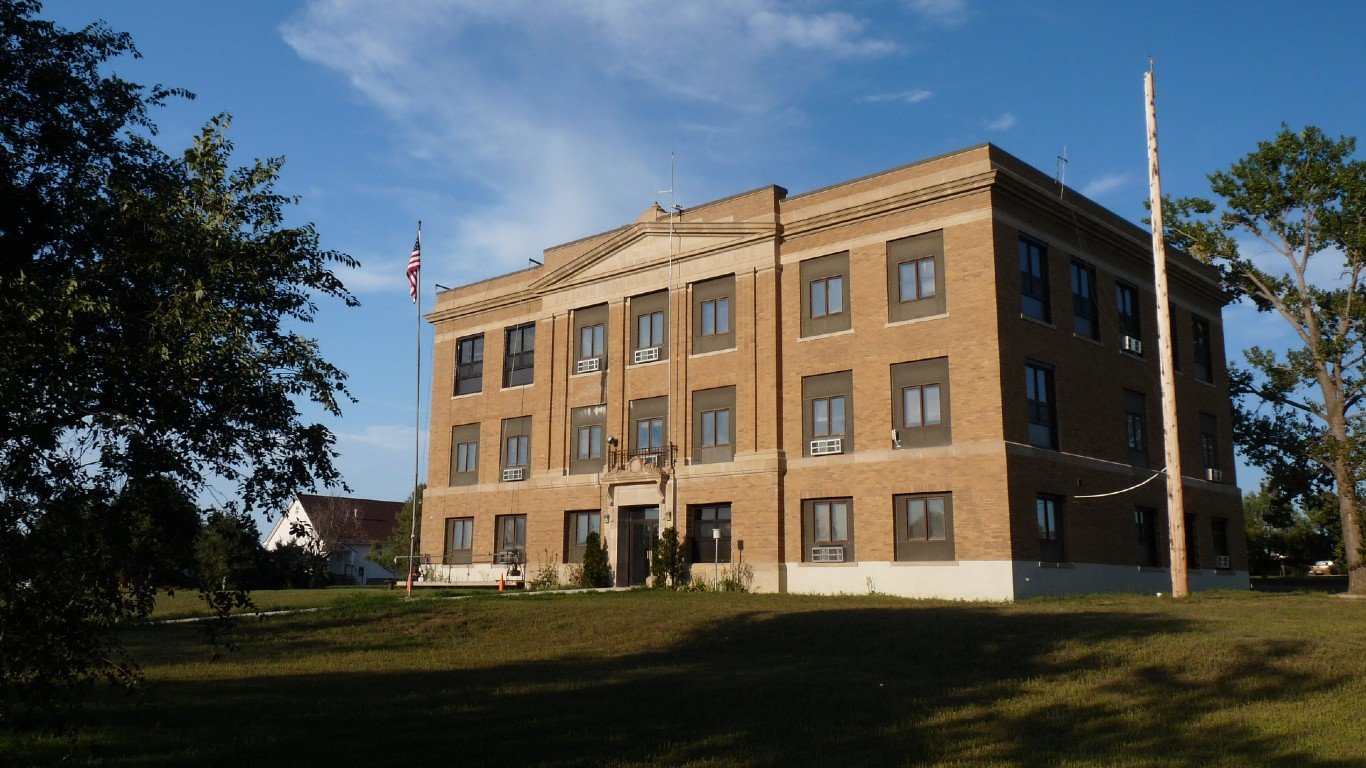
34. Ziebach County, South Dakota
> Poverty rate: 42.5%
> Adults with a bachelor’s degree: 16.4%
> Life expectancy at birth: 77.2 years
> Total population: 2,791
> Largest place in county: Eagle Butte
Ziebach County, South Dakota, which lies mostly within the Cheyenne River Indian Reservation, is one of the poorest places in the United States. Nearly 43% of the local population live below the poverty line, the seventh largest share of all U.S. counties and county equivalents. Low incomes, which can make it difficult to access health care and afford healthy lifestyles, are compounded by certain unhealthy behaviors in the county. For example, 32% of local adults smoke and 52% of adults are obese, compared to 17% and 29% of the U.S. adult population, respectively.
As is often the case in low-income areas with large unhealthy populations, Ziebach County has low educational attainment rates. For example, just 16.4% of local adults have a bachelor’s degree, about half the share of adults nationwide.
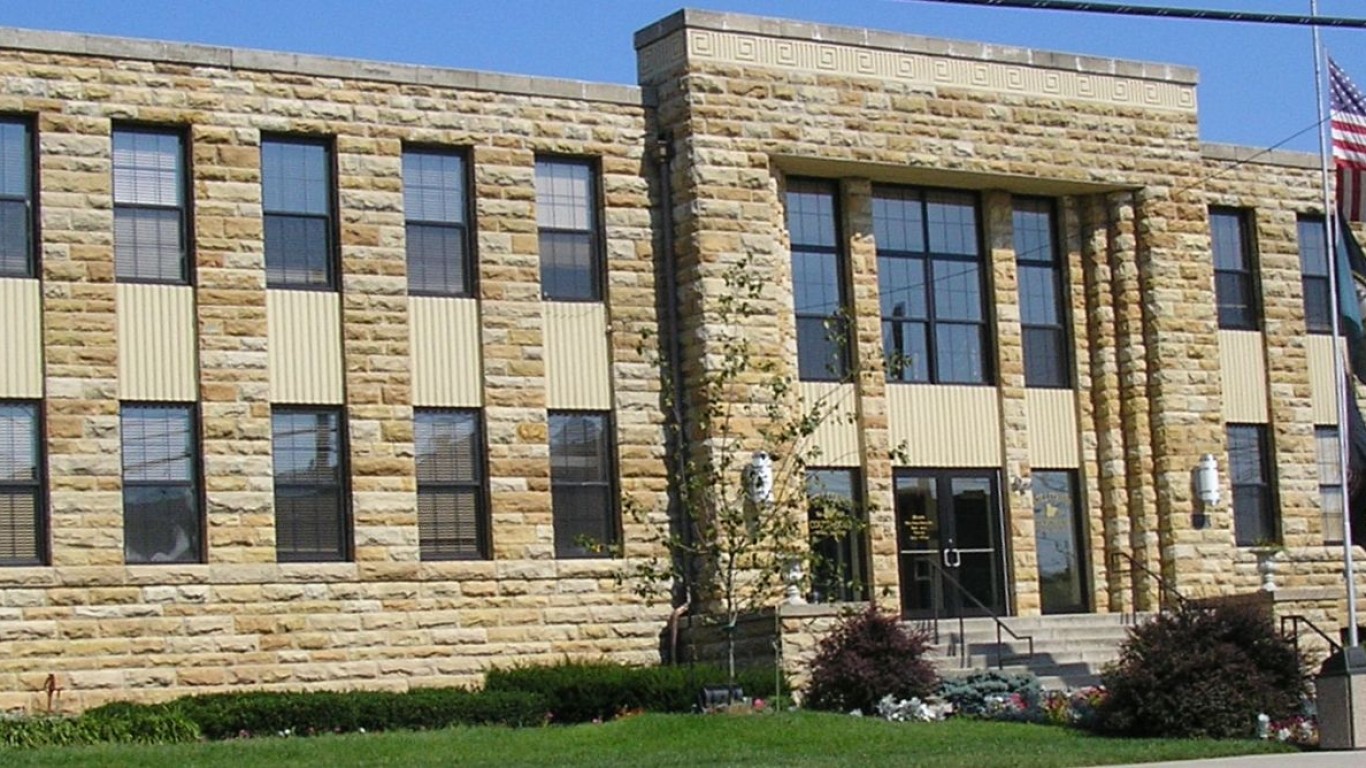
33. Estill County, Kentucky
> Poverty rate: 30.9%
> Adults with a bachelor’s degree: 9.9%
> Life expectancy at birth: 71.4 years
> Total population: 14,224
> Largest place in county: Irvine
Many of the places with the worst socioeconomic conditions and public health outcomes are in Appalachia, and Estill County, Kentucky, is one of them. Historically, the local economy has centered on coal mining, and as the U.S. energy grid moves away from coal, places like Estill County suffer. Today, nearly 31% of the local population live below the poverty line.
Life expectancy in the county is also nearly eight years below the national average. This is attributable in part to the toll the opioid epidemic is taking on the local population. There are an average of 60 drug overdose deaths for every 100,000 people in the county annually, nearly triple the comparable national rate.

32. Humphreys County, Mississippi
> Poverty rate: 36.4%
> Adults with a bachelor’s degree: 12.8%
> Life expectancy at birth: 74.1 years
> Total population: 8,389
> Largest place in county: Belzoni
Humphreys County, Mississippi, is one of the worst places to live in the United States partially because life expectancy at birth is just 74.1 years — half a decade shy of the national average.
Low life expectancy in Humphreys County is due in part to widespread poverty. Of the nearly 8,400 people living in the area, 36.4% live below the poverty line, more than double the 13.4% national poverty rate. Certain unhealthy behaviors may also be a factor. Adult county residents are far more likely to smoke and be obese, and far less likely to exercise, than they typical American adult.
[in-text-ad-2]

31. Phillips County, Arkansas
> Poverty rate: 34.5%
> Adults with a bachelor’s degree: 13.8%
> Life expectancy at birth: 71.8 years
> Total population: 18,606
> Largest place in county: West Helena
Phillips County, located in Arkansas’s Delta region where the St. Francis River empties into the Mississippi River, is one of the worst places to live in the United States. A former agricultural and transportation hub, the county has long been in decline. As recently as 1950, over 46,000 people lived in the county. Today, only 18,600 do.
Financial insecurity is high in Phillips County, as 34.5% of local residents live below the poverty line. Limited job availability partially explains the widespread poverty in the county. As of January 2021, 13.8% of the area’s labor force were unemployed. Even before the COVID-19 pandemic, the local 2019 unemployment rate stood at 10.1%, well above the comparable 3.7% national rate.
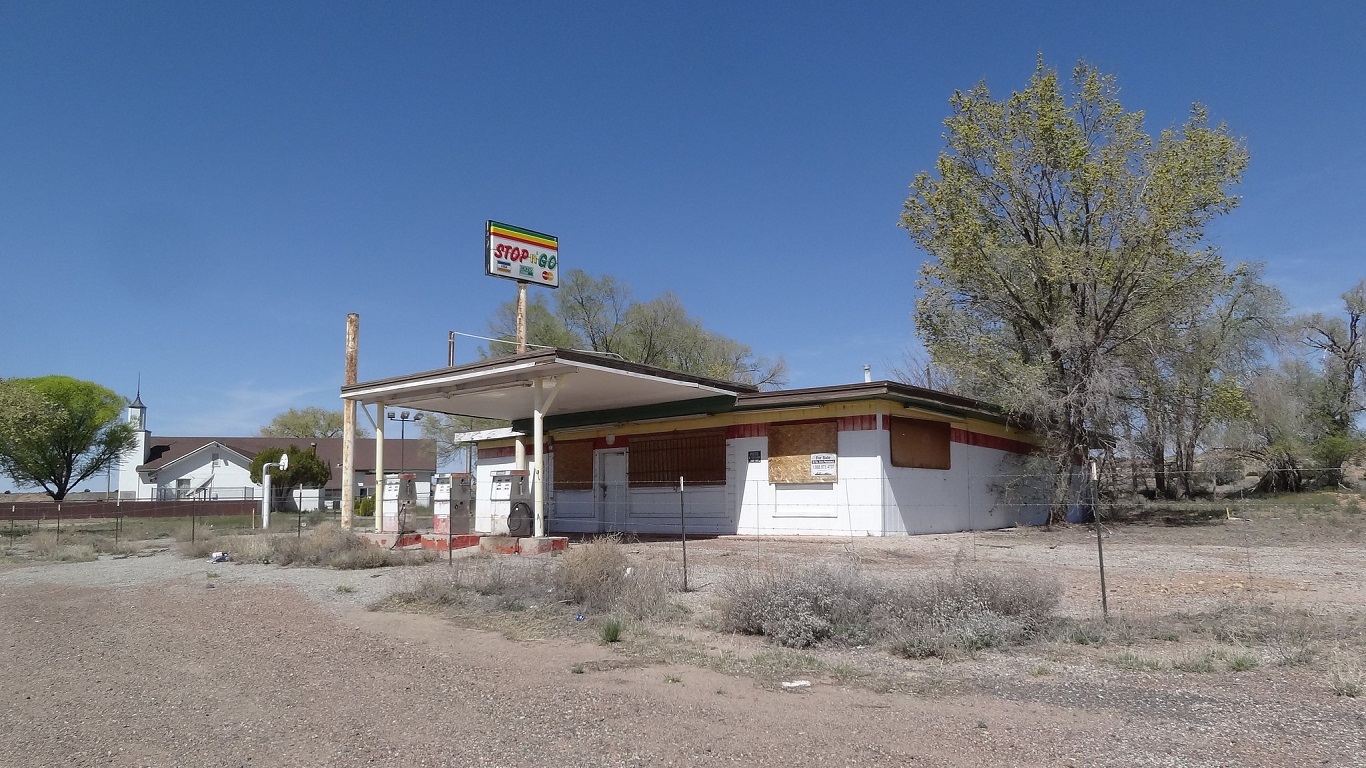
30. Apache County, Arizona
> Poverty rate: 35.5%
> Adults with a bachelor’s degree: 12.3%
> Life expectancy at birth: 72.9 years
> Total population: 71,511
> Largest place in county: Chinle
Apache County, Arizona, is located in the northeast corner of the state and covers much of the Navajo Nation. Like many counties with large Native American populations, economic opportunity is scarce in Apache County. More than one-third of the population live below the poverty line, more than one in every 10 members of the labor force are unemployed, and more than one in every five households earn less than $10,000 a year.
Such limited economic opportunity and widespread poverty can take a public health toll. In Apache County, life expectancy at birth is only about 73 years — six years shy of the national average.
[in-text-ad]
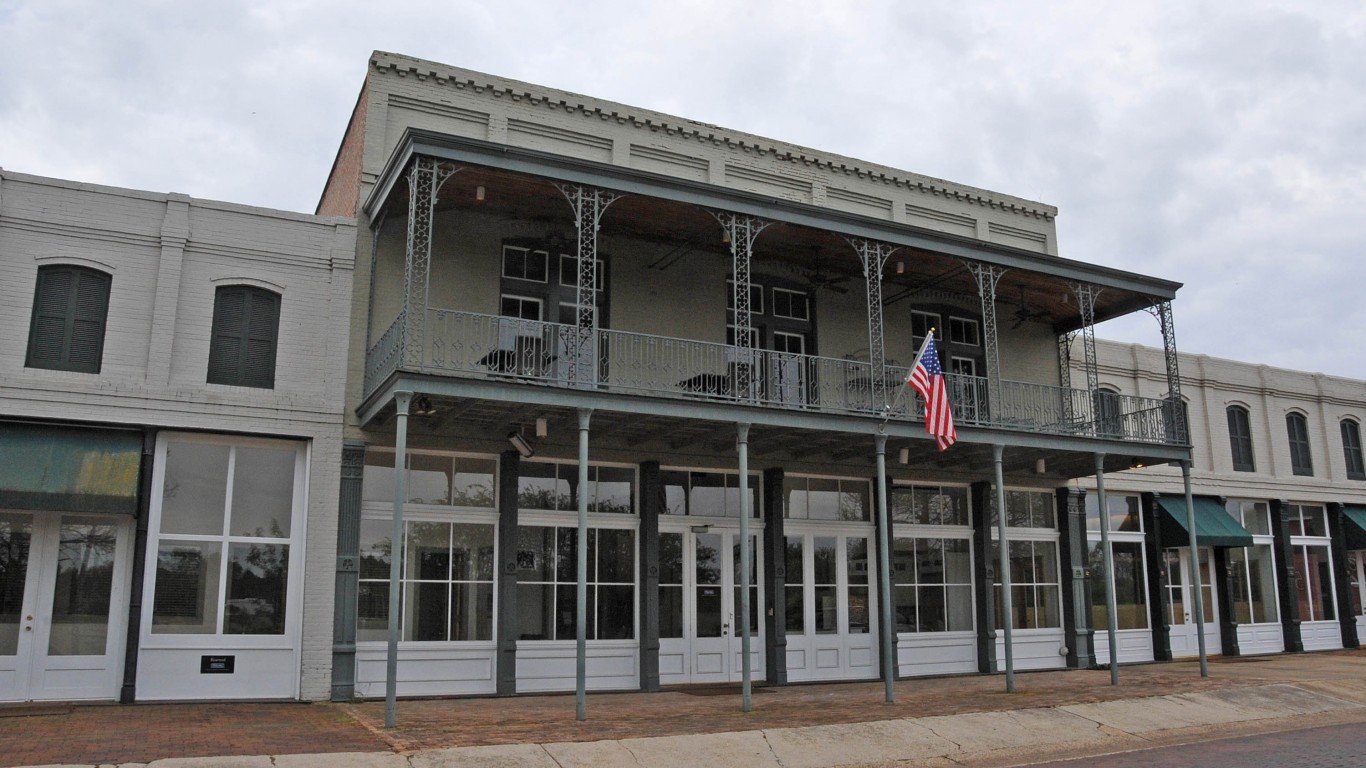
29. Leflore County, Mississippi
> Poverty rate: 36.8%
> Adults with a bachelor’s degree: 18.5%
> Life expectancy at birth: 70.5 years
> Total population: 29,222
> Largest place in county: Greenwood
Leflore County, Mississippi, is located in the state’s Delta region. Its ranking as one of the worst places to live in the United States is due in large part to relatively poor health outcomes. Life expectancy at birth in the county is just 70.5 years, nearly nine years below the national average. This is partially the result of certain unhealthy behaviors. Adult county residents are far more likely to smoke and be obese, and far less likely to exercise, than they typical American adult.
Many residents are also severely limited in their ability to afford adequate medical care and healthy lifestyles. Leflore County’s poverty rate of 36.8% is among the 20 highest of all U.S. counties and county equivalents.
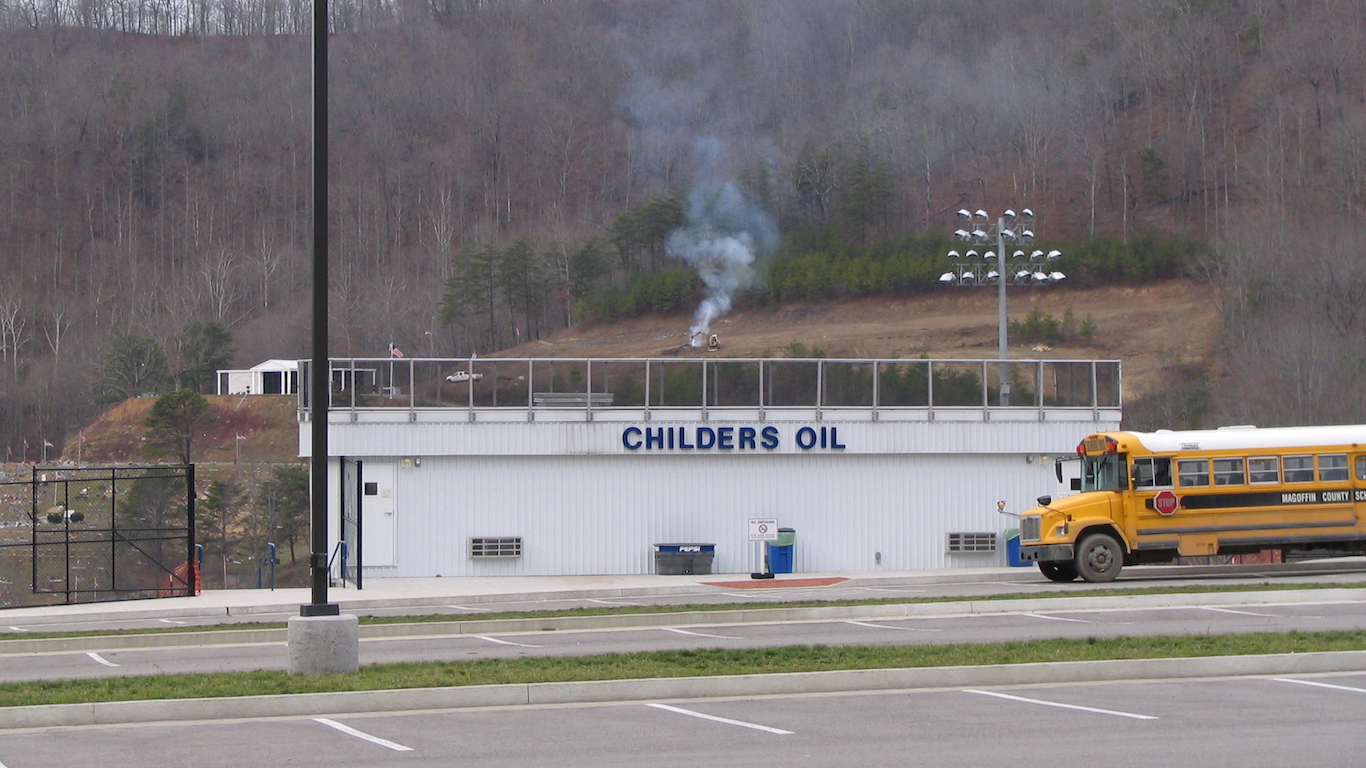
28. Letcher County, Kentucky
> Poverty rate: 33.6%
> Adults with a bachelor’s degree: 12.1%
> Life expectancy at birth: 71.3 years
> Total population: 22,295
> Largest place in county: Jenkins
Letcher County, Kentucky, is one of several counties in the state’s eastern coalfield region to rank among the worst places to live in the United States. As is the case in other nearby counties, many in Letcher County are unable to make ends meet. Over a third of the population live below the poverty line, and 17.4% of area households earn less than $10,000 a year, each among the highest shares of any U.S county.
Incomes tend to rise with educational attainment, and in Letcher County, only 12.1% of adults have a bachelor’s degree and 75.7% have a high school diploma, well below the comparable national shares of 32.1% and 88.0%, respectively. Job opportunities are limited as well in the area, as the local unemployment rate stood at 8.2% as of January 2021.
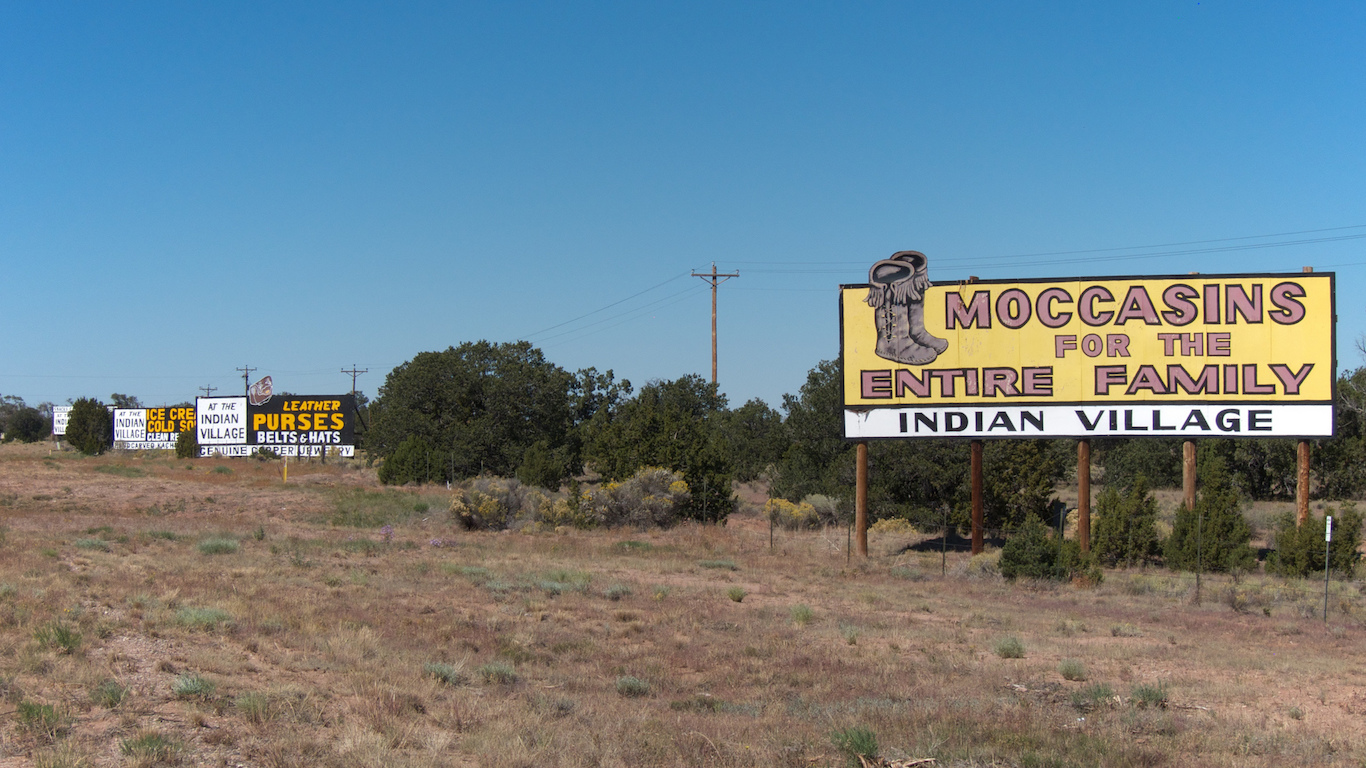
27. McKinley County, New Mexico
> Poverty rate: 34.8%
> Adults with a bachelor’s degree: 11.4%
> Life expectancy at birth: 72.2 years
> Total population: 72,438
> Largest place in county: Gallup
McKinley County, New Mexico, is located in the northwestern part of the state and covers parts of the Navajo and Zuni Indian Reservations. Native Americans are among the most disenfranchised groups in the United States, and the poor economic and public health conditions common in many Native American populations are prevalent in McKinley County as well.
The January 2021 unemployment rate in the county is 12% — well above the comparable 6.8% national rate. Additionally, nearly 35% of the local population live below the poverty line, compared to 13.4% of Americans nationwide. Perhaps the most telling disparity in McKinley County, however, is life expectancy at birth, which, at just 72.2 years, is nearly seven years less than the national average.
[in-text-ad-2]
26. Wilkinson County, Mississippi
> Poverty rate: 34.7%
> Adults with a bachelor’s degree: 13.7%
> Life expectancy at birth: 70.8 years
> Total population: 8,875
> Largest place in county: Centreville
Wilkinson County, Mississippi, is one of the worst places to live in the United States, largely because of the relatively poor health outcomes in the area. Life expectancy at birth in the county, located in southwestern corner of the state, is just 70.8 years, over eight years less than the national average. Adult county residents are far more likely to smoke and be obese, and far less likely to exercise, than they typical American adult.
Widespread poverty, resulting in part from a weak job market, also contributes to low quality of life in the area. Over a third of all county residents live below the poverty line, and 13.9% of the local labor force are unemployed, each among the highest shares of any U.S. county or county equivalent.
25. Jefferson County, Mississippi
> Poverty rate: 37.6%
> Adults with a bachelor’s degree: 15.9%
> Life expectancy at birth: 71.9 years
> Total population: 7,225
> Largest place in county: Fayette
Jefferson County, located in the southwestern section of Mississippi, is one of several counties in the state to rank among the worst places to live — largely because it is one of the poorest counties in the United States. About 38% of the county’s 7,300 residents live below the poverty line. Widespread poverty is partially the result of a lack of jobs. As of January 2021, 17.0% of the local labor force were unemployed, a higher jobless rate than in all but six other U.S. counties and county equivalents.
As is often the case in areas with low incomes and limited job opportunities, educational attainment is low in Jefferson County. Just 15.9% of area adults have a bachelor’s degree or higher, about half the national share, and 78% of local adults have a high school diploma, 10 percentage points below the national share.
[in-text-ad]

24. Breathitt County, Kentucky
> Poverty rate: 34.4%
> Adults with a bachelor’s degree: 15.2%
> Life expectancy at birth: 69.7 years
> Total population: 12,977
> Largest place in county: Jackson
Breathitt County, Kentucky, is one of the worst places to live in the United States largely because of the relatively poor health outcomes in the area. The county, located in the state’s eastern coalfield region in the Appalachian Mountains, is one of only 24 counties nationwide where life expectancy at birth is less than 70 years. As is the case in much of Appalachia, Breathitt County has been severely affected by the opioid epidemic. There are nearly 31 deaths for every 100,000 people in the county due to drug overdoses annually, compared to 21 per 100,000 nationwide.
Poor health outcomes are also due to widespread financial hardship. The local poverty rate in Breathitt County stands at 34.4% — well more than double the 13.4% national poverty rate.

23. Madison Parish, Louisiana
> Poverty rate: 36.4%
> Adults with a bachelor’s degree: 12.8%
> Life expectancy at birth: 72.4 years
> Total population: 11,306
> Largest place in parish: Tallulah
Madison Parish, located in northeastern Louisiana along the Mississippi River, ranks among the worst places to live largely because of widespread poverty. Some 36.4% of the local population live below the poverty line, meaning that residents of Madison Parish are well more than twice as likely to face serious financial hardship than the typical American.
Incomes tend to rise with educational attainment, and in Madison Parish, only 12.8% of adults have a bachelor’s degree and 73.9% have a high school diploma, well below the respective national shares of 32.1% and 88.0%.
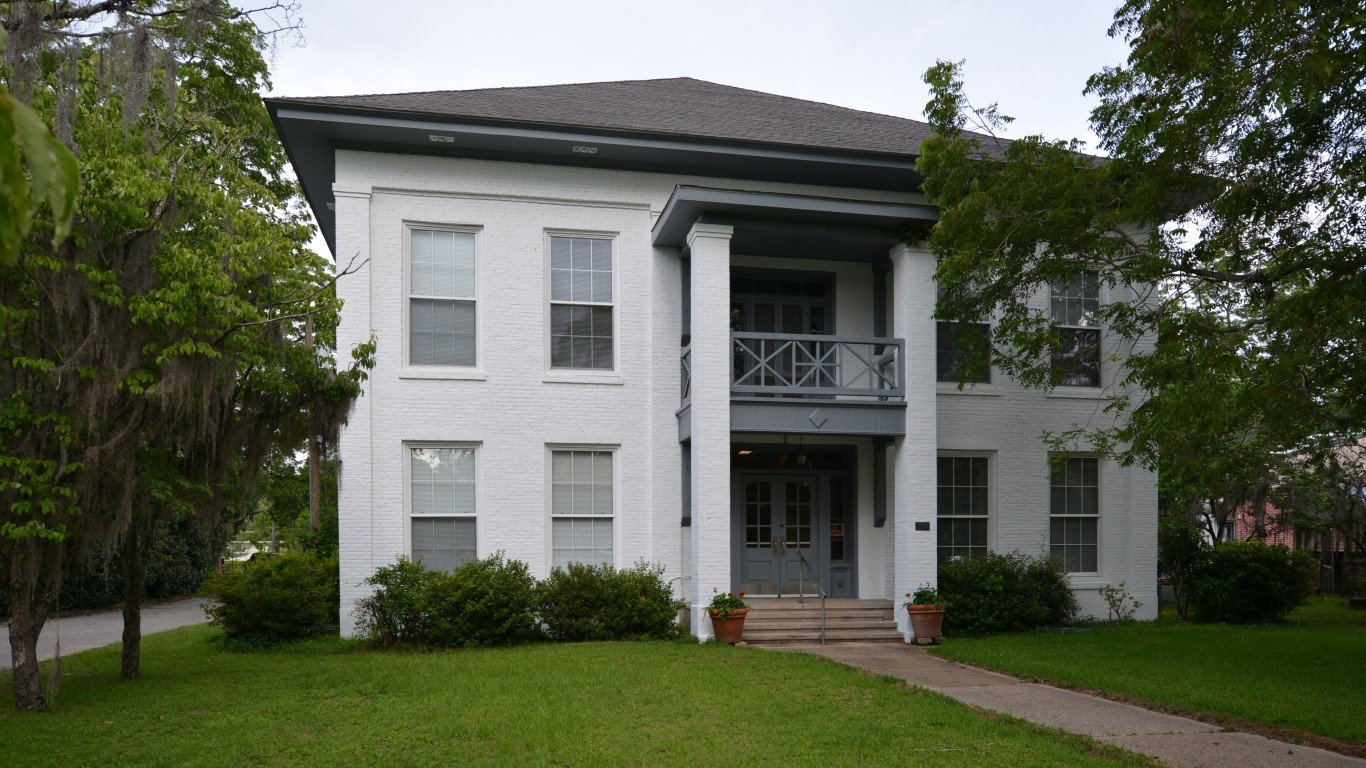
22. Clay County, Georgia
> Poverty rate: 39.5%
> Adults with a bachelor’s degree: 12.5%
> Life expectancy at birth: 74.6 years
> Total population: 2,951
> Largest place in county: Fort Gaines
Clay County is located in western Georgia along the state border with Alabama. One of the poorest parts of the country, Clay is one of only 13 counties or county equivalents nationwide where over 39% of the population live below the poverty line. Low incomes can take a toll on health outcomes as people living below the poverty line often cannot afford adequate health care and healthy lifestyles. In Clay County, life expectancy is just 74.6 years at birth, about five a half years below the national average.
Financial hardship in the area is due in part to a lack of jobs. As of January 2021, unemployment in Clay County stood at 11.5%, well above the comparable 6.8% national unemployment rate.
[in-text-ad-2]
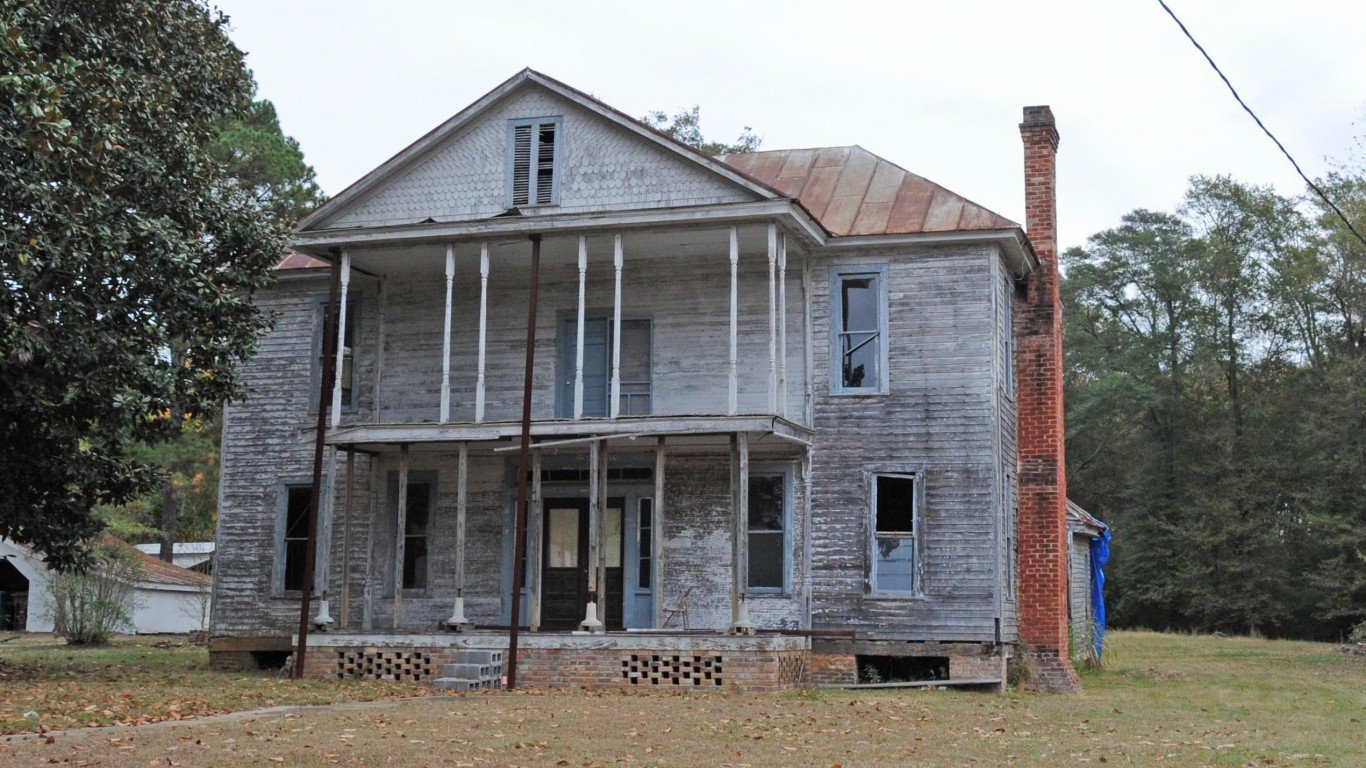
21. Greene County, Alabama
> Poverty rate: 38.1%
> Adults with a bachelor’s degree: 10.1%
> Life expectancy at birth: 74.8 years
> Total population: 8,324
> Largest place in county: Eutaw
Greene County, located in west-central Alabama, is the only county in the state to rank among the worst places to live in the United States. Greene County is one of the poorest counties in the country with a 38.1% poverty rate — among the 20 highest poverty rates of any U.S. county or county equivalent.
The area’s widespread poverty coupled with some pervasive unhealthy behaviors likely contribute to the low average life expectancy in the county. Nearly one-quarter of local adults are smokers and over a third are obese, each higher than the national figures of 17.1% and 29.0%, respectively. Smoking is the leading cause of preventable death in the United States, and obesity is a risk factor for a number of potentially life threatening diseases and conditions. Life expectancy birth in Greene County is just 74.8 years, over four years less than the national average.
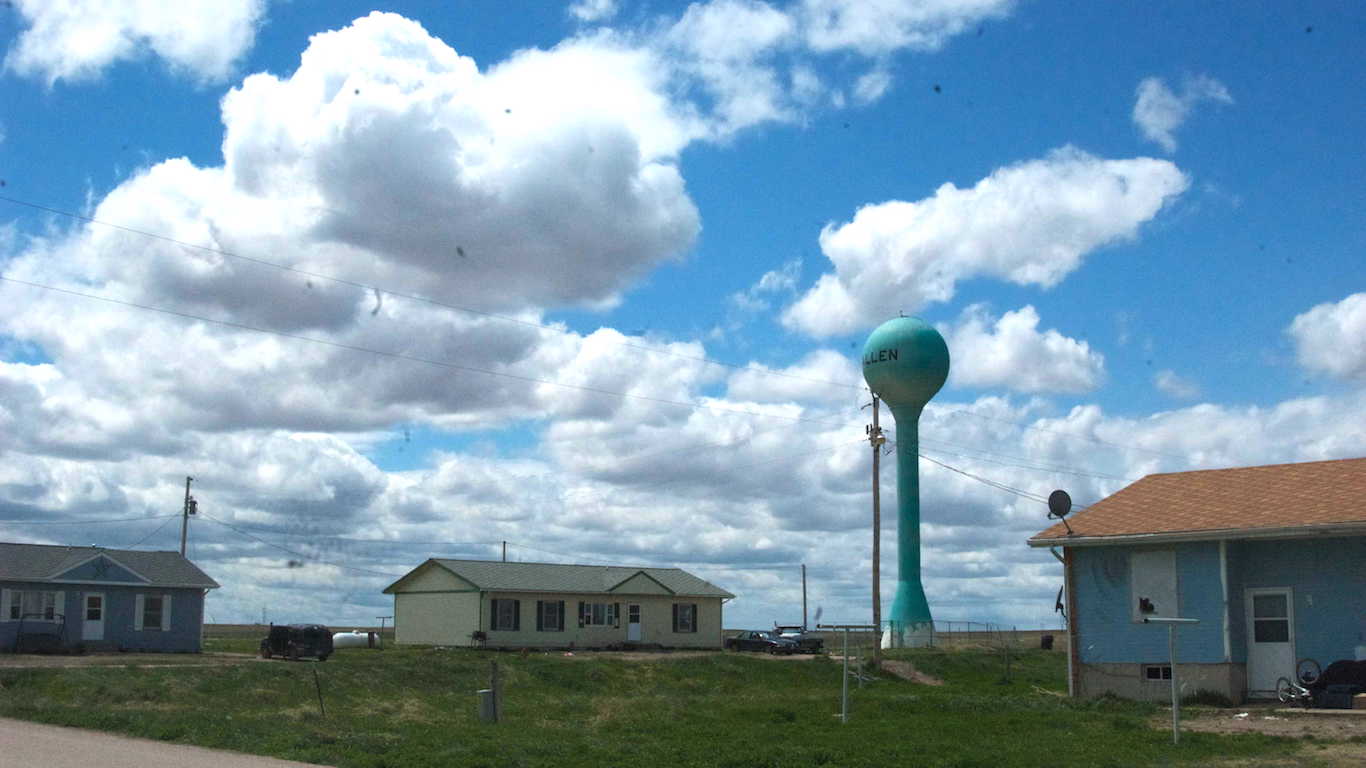
20. Bennett County, South Dakota
> Poverty rate: 35.9%
> Adults with a bachelor’s degree: 15.7%
> Life expectancy at birth: 69.1 years
> Total population: 3,425
> Largest place in county: Martin
Bennett County lies within South Dakota’s Pine Ridge Reservation, an area struggling with several social, economic, and public health problems. For example, nearly 42% of adults in the county are obese, and by some estimates, one in every four babies born on the broader reservation have fetal alcohol syndrome. Life expectancy at birth in the county is just 69.1 years, a full decade below the national average.
For a variety of reasons, Americans with lower educational attainment often make less healthy lifestyle decisions, and those living below the poverty line often cannot afford adequate medical care or nutritious diets. In Bennett County, only 15.7% of adults have a bachelor’s degree and 35.9% of the population live below the poverty line, compared to the respective national rates of 32.1% and 13.4%.
[in-text-ad]

19. Quitman County, Mississippi
> Poverty rate: 35.6%
> Adults with a bachelor’s degree: 10.3%
> Life expectancy at birth: 71.7 years
> Total population: 7,187
> Largest place in county: Marks
With one of the lowest life expectancies in the United States and one of the highest poverty rates, Quitman County, located in northwestern Mississippi, ranks among the worst U.S. counties to live in. The 35.6% local poverty rate is more than double the national poverty rate, and life expectancy at birth in the area is just 71.7 years, about seven years shorter than the national average.
Employment opportunities are relatively limited in the county. As of January 2021, 10.1% of the local labor force were unemployed, well above the comparable national unemployment rate of 6.8%.

18. McCreary County, Kentucky
> Poverty rate: 33.4%
> Adults with a bachelor’s degree: 7.2%
> Life expectancy at birth: 71.4 years
> Total population: 17,465
> Largest place in county: Pine Knot
McCreary County, Kentucky, is one of many in Appalachia with economic fortunes that are closely tied to the U.S. coal industry. Coal mining jobs once offered a living wage in the region without requiring a postsecondary education, and now, as U.S. energy production continues to shift away from coal, mining jobs in McCreary County have vanished. Throughout the early and mid-20th century, over two dozen coal mines in the county employed hundreds of local residents. Even as recently as 2012, the county produced nearly 32,000 tons of coal. Now, coal production has ground to a halt in the county.
About one in every three of the 17,500 people living in McCreary County live below the poverty line, and economic opportunities are limited for many in the area partly also because of the limited educational attainment in the county. Only 7.2% of area adults have a bachelor’s degree and 76.6% have a high school diploma, well below the respective national shares of 32.1% and 88.0%.
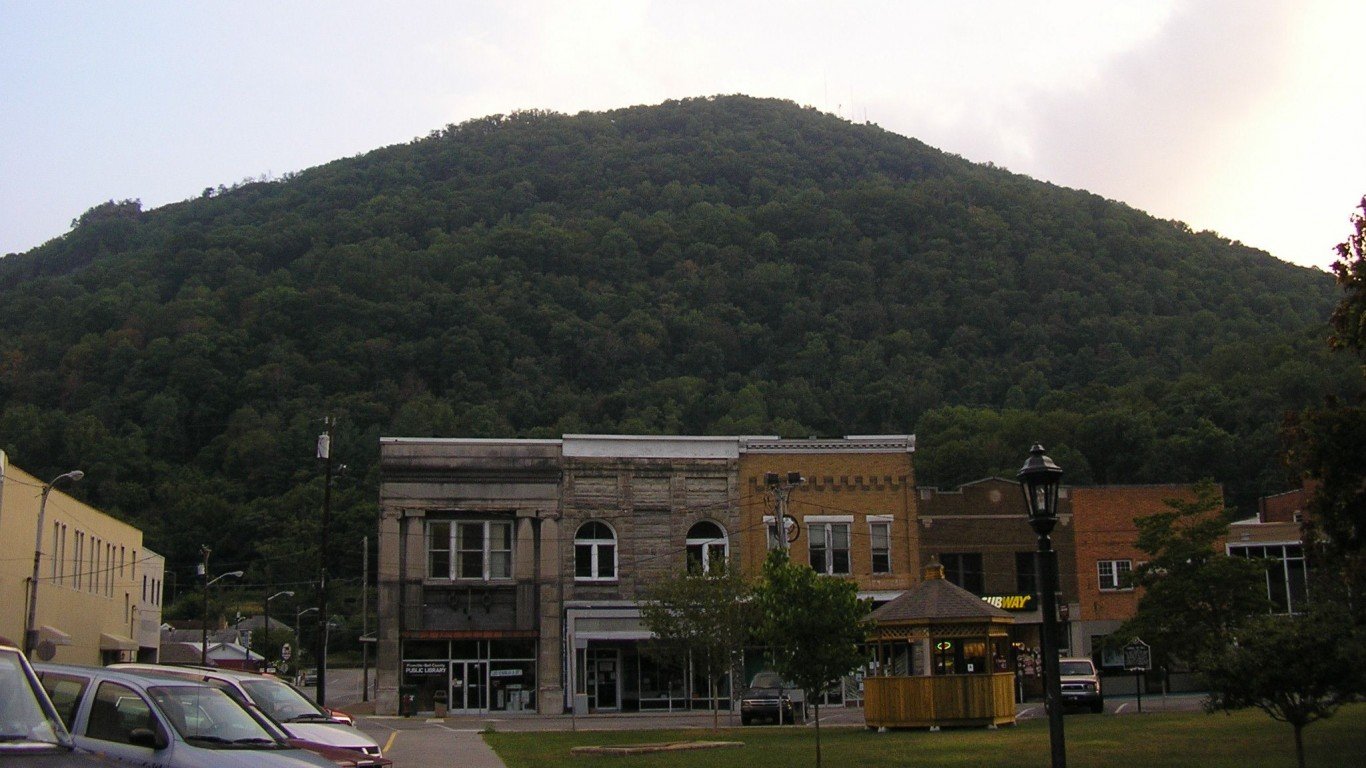
17. Bell County, Kentucky
> Poverty rate: 35.5%
> Adults with a bachelor’s degree: 9.2%
> Life expectancy at birth: 71.9 years
> Total population: 26,791
> Largest place in county: Middlesborough
Bell County, located in Kentucky’s southeastern corner, is one of many coal-producing counties in Appalachia to rank among the worst places to live. As is the case in much of the region, Bell County is characterized by widespread poverty and poor public health outcomes. The local poverty rate stands at 35.5%, more than double the 13.4% national rate. Additionally, life expectancy at birth in the county is about 72 years, seven years below the national average.
Across broad populations, both health outcomes and incomes tend to improve with educational attainment. In Bell County, only 9.2% of adults have a bachelor’s degree or higher, less than a third of the 32.1% share of adults nationwide who do.
[in-text-ad-2]
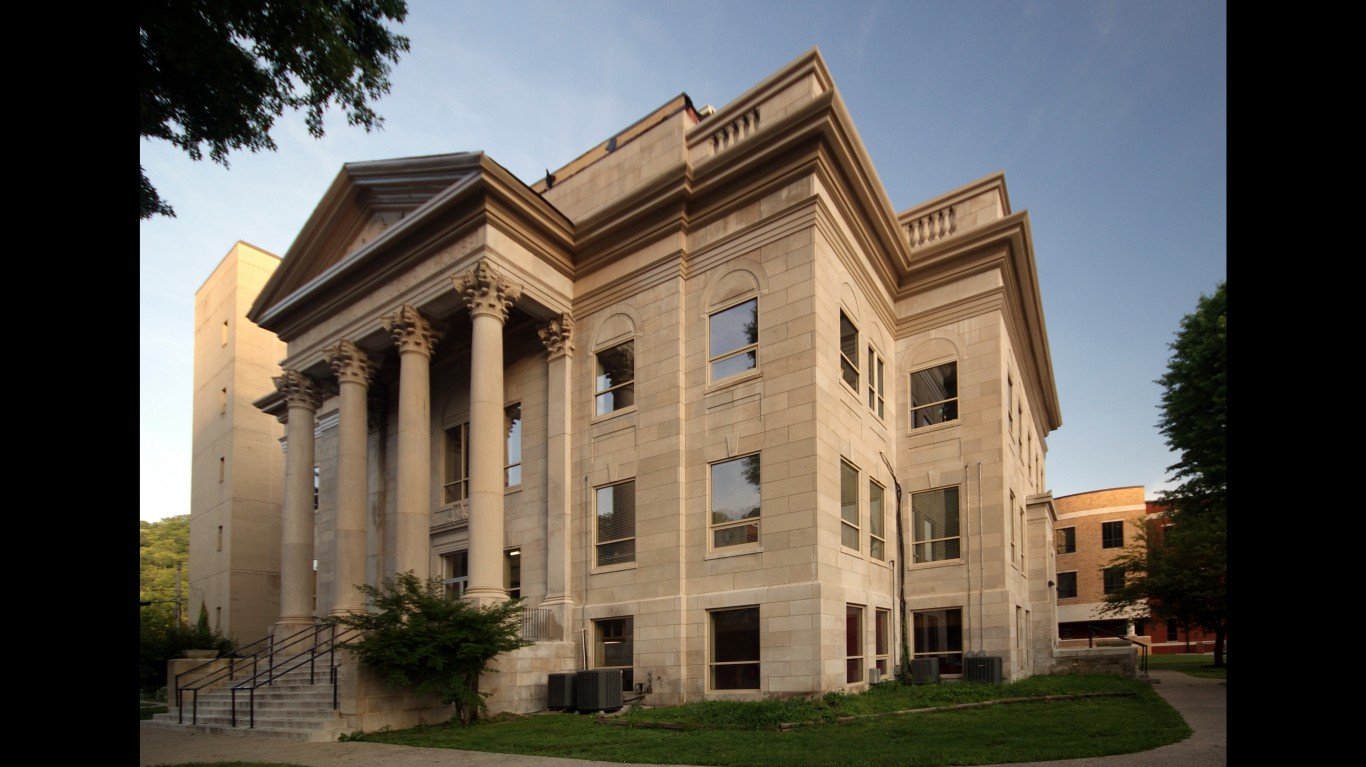
16. Harlan County, Kentucky
> Poverty rate: 36.0%
> Adults with a bachelor’s degree: 10.8%
> Life expectancy at birth: 70.5 years
> Total population: 26,699
> Largest place in county: Cumberland
Harlan County, Kentucky, located in the state’s eastern coalfield region, is one of the worst places to live in the United States largely due to widespread poverty. An estimated 36% of local residents live below the poverty line, and nearly 19% of households earn less than $10,000 a year — more than triple the comparable share of households nationwide.
Life expectancy at birth in the county is also nearly nine years below the national average. This is attributable in part to the toll the opioid epidemic is taking on the local population. There are an average of 36 drug overdose deaths for every 100,000 people in the county annually, compared to about 21 per 100,000 nationwide.

15. Clay County, Kentucky
> Poverty rate: 36.6%
> Adults with a bachelor’s degree: 9.8%
> Life expectancy at birth: 71.0 years
> Total population: 20,368
> Largest place in county: Manchester
Clay County, Kentucky, borders four other counties in the state that also rank among the worst places to live in the United States. As is the case in some of its neighboring counties in Kentucky’s eastern coalfield region, adults in Clay are far less likely than most Americans to have a college education. Just 9.8% of area residents 25 and older have a bachelor’s degree or higher compared to 32.1% of adults nationwide.
Adults who have completed college have greater access to economic opportunities and are more likely to have a healthier lifestyle. In Clay County, 36.6% of the population live in poverty, and life expectancy at birth is just 71.0 years — compared to the 13.4% national poverty rate and the 79.1 year national life expectancy.
[in-text-ad]
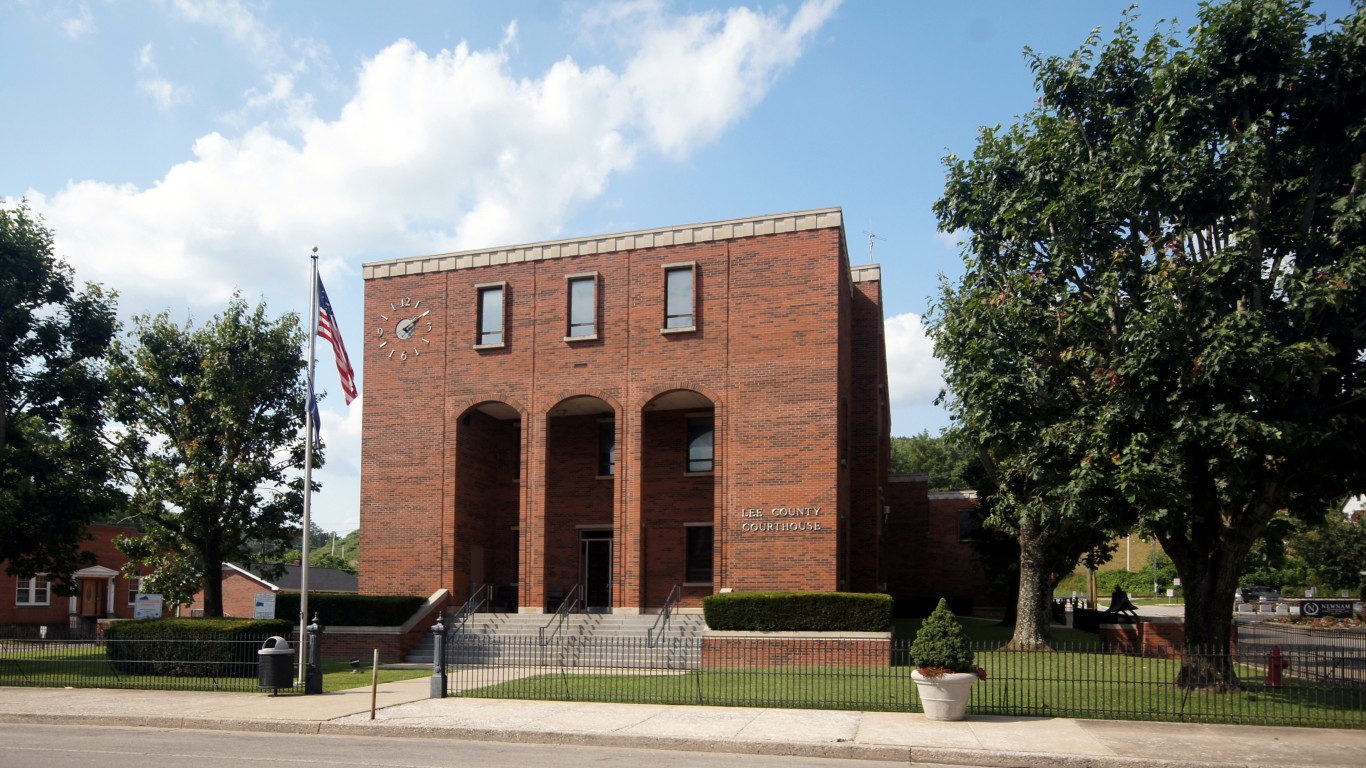
14. Lee County, Kentucky
> Poverty rate: 34.6%
> Adults with a bachelor’s degree: 8.3%
> Life expectancy at birth: 70.1 years
> Total population: 6,881
> Largest place in county: Beattyville
Lee County, Kentucky, is located in the state’s Eastern Coalfield region. Like many coal-producing regions of the United States, Lee County is struggling with severe economic and public health problems. For example, over one-third of the local population live below the poverty line and nearly one in every four households earn less than $10,000 a year.
As is the case in much of Appalachia, Lee County has been severely affected by the opioid epidemic. There are over 64 deaths for every 100,000 people in the county due to drug overdoses annually, more than triple the national rate of 21 deaths per 100,000 people. Partially as a result, life expectancy is only 70 years in the county, nine years below the national average.
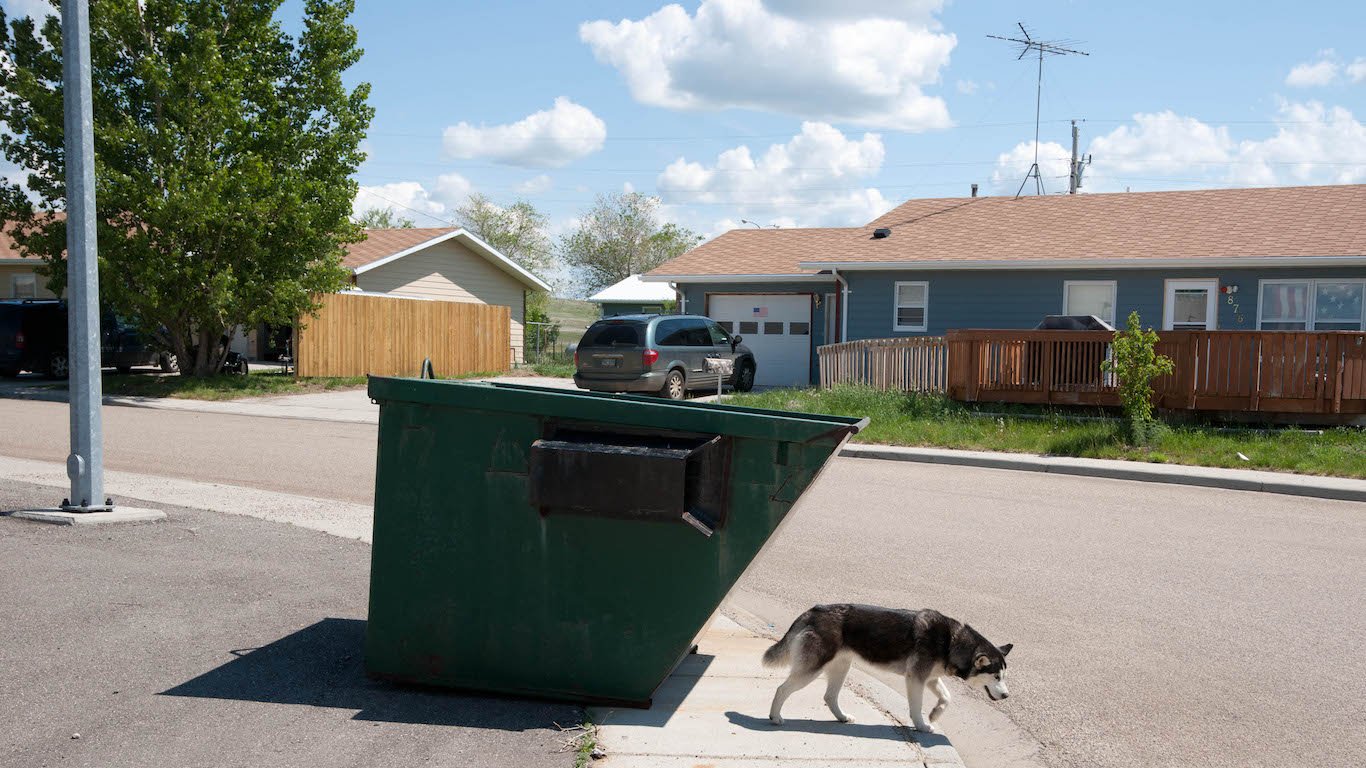
13. Sioux County, North Dakota
> Poverty rate: 38.2%
> Adults with a bachelor’s degree: 15.0%
> Life expectancy at birth: 68.5 years
> Total population: 4,373
> Largest place in county: Cannon Ball
Sioux County covers the entirety of the North Dakota portion of the Standing Rock Indian Reservation. For a range of historical reasons and present-day laws, reservations tend to struggle economically considerably more than much of the country — and Sioux County is no exception.
An estimated 38.2% of the county’s population live below the poverty line, nearly triple the national poverty rate. Poverty can take a significant negative toll on overall health, and in Sioux County, the obesity rate of 39% is 10 percentage points higher than the national average and local adults are twice as likely to have diabetes as the typical American adult. At just 68.5 years, life expectancy at birth in the area is among the lowest in the United States.

12. Clinch County, Georgia
> Poverty rate: 40.2%
> Adults with a bachelor’s degree: 10.0%
> Life expectancy at birth: 72.7 years
> Total population: 6,686
> Largest place in county: Homerville
Clinch County, Georgia, located along the Florida border, ranks as the worst place to live in the state and one of the worst nationwide. One of the poorest places in the country, Clinch County’s poverty rate of 40.2% is triple the national poverty rate. The area’s low incomes are attributable in part to low educational attainment as only one in 10 local adults have a bachelor’s degree or higher, compared to more than three in 10 adults who do nationwide.
Life expectancy is about six years lower than average in Clinch County. The low life expectancy is partially due to unhealthy lifestyles in the area. Adults in the county are less likely to exercise than most U.S. adults, and over half the adult population are obese. The presence of parks and recreation centers can encourage physical activity and improve overall quality of life. In Clinch County, just 5.1% of the population have easy access to such places, well below the 84.2% share of Americans nationwide who do.
[in-text-ad-2]
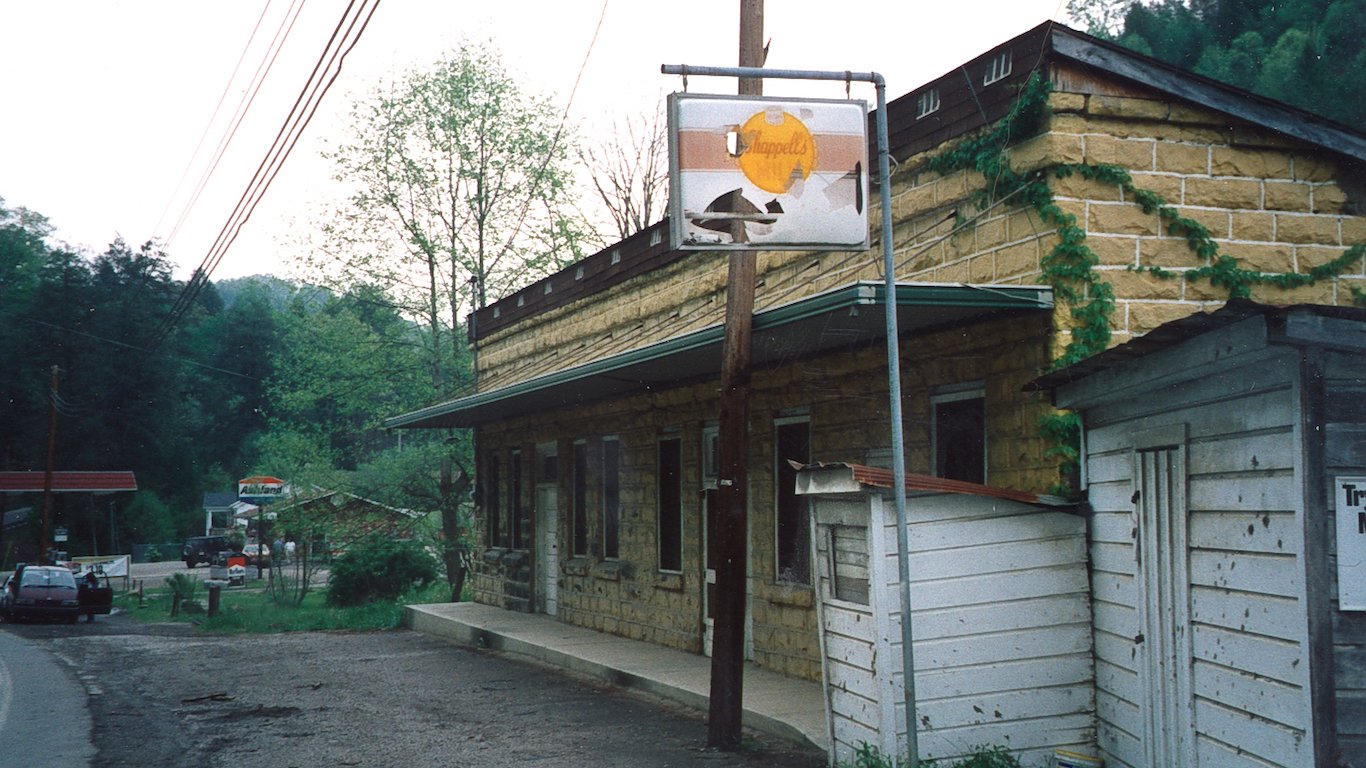
11. Leslie County, Kentucky
> Poverty rate: 38.0%
> Adults with a bachelor’s degree: 8.7%
> Life expectancy at birth: 71.5 years
> Total population: 10,283
> Largest place in county: Hyden
Many counties in Kentucky’s Eastern Coalfield Region rank among the worst places to live in the United States, but of them, Leslie County is the worst. Like many other coal-producing regions of the United States, Leslie County is struggling economically. As of January 2021, 9.0% of the local labor force were unemployed, well above the 6.8% national unemployment rate. Even before the COVID-19 pandemic, the local 2019 unemployment rate stood at 8.2%, well above the comparable 3.7% national rate. Partially as a result, 38% of the population live below the poverty line, compared to the 13.4% national poverty rate.
Employment opportunities typically rise with educational attainment, and in the county, fewer than one in every 10 adults have a bachelor’s degree. Nationwide, over 30% of adults do.
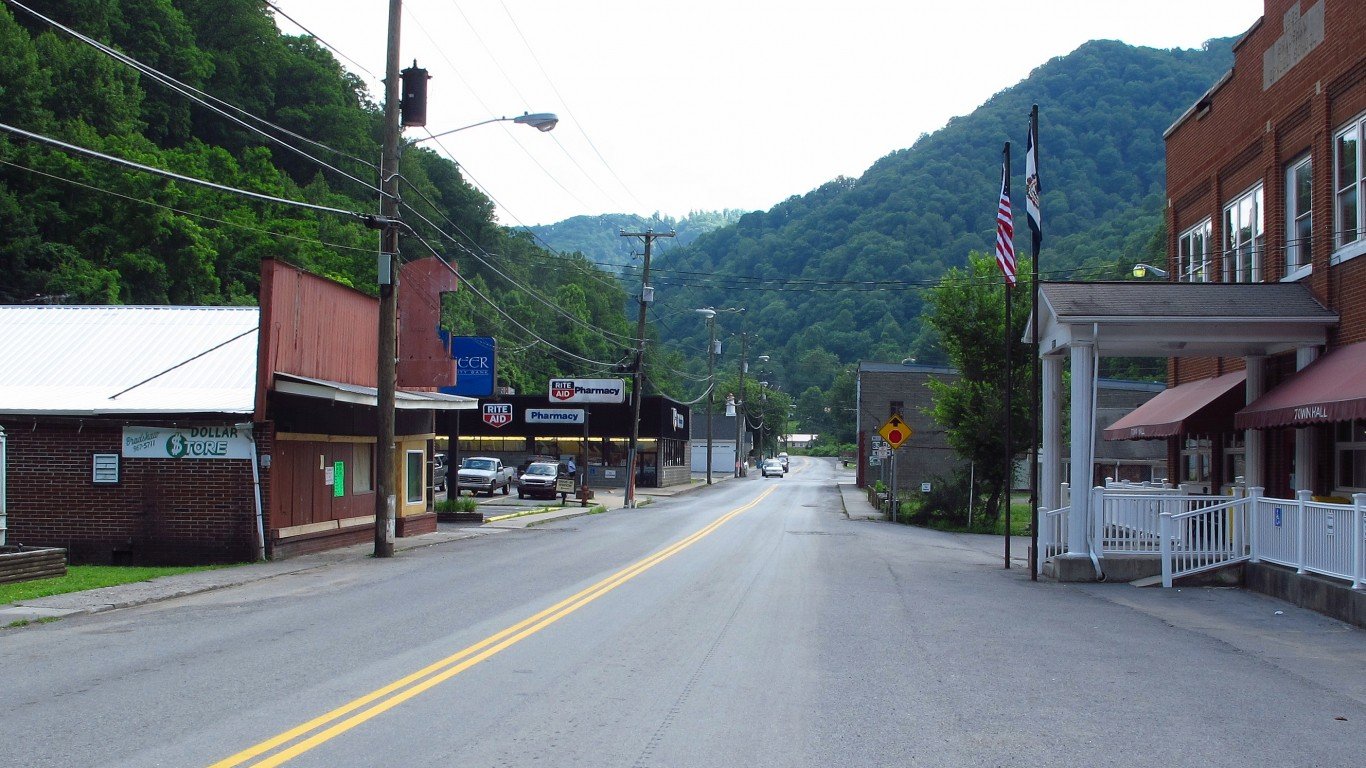
10. McDowell County, West Virginia
> Poverty rate: 33.2%
> Adults with a bachelor’s degree: 5.4%
> Life expectancy at birth: 68.6 years
> Total population: 18,661
> Largest place in county: Welch
McDowell County, West Virginia, located in the heart of Appalachian coal country, has been decimated with the decline of the American coal mining industry. Home to nearly 100,000 people at its peak in 1950, McDowell’s population is now less than 20,000. As of January 2021, 11.0% of the local labor force were unemployed, well above the 6.8% national unemployment rate. Even before the COVID-19 pandemic, the local 2019 unemployment rate stood at 9.2%, well above the comparable 3.7% national rate. Of those who remain in the county, nearly one in every three live below the poverty line.
Additionally, like many parts of West Virginia, McDowell County has been particularly hard hit by the opioid epidemic. There are nearly 84 deaths for every 100,000 people in the county due to drug overdoses annually, more four times the comparable national rate of 21 deaths per 100,000 people. Partially as a result, life expectancy is only 68.6 years in the county, over a decade below the national average.
[in-text-ad]
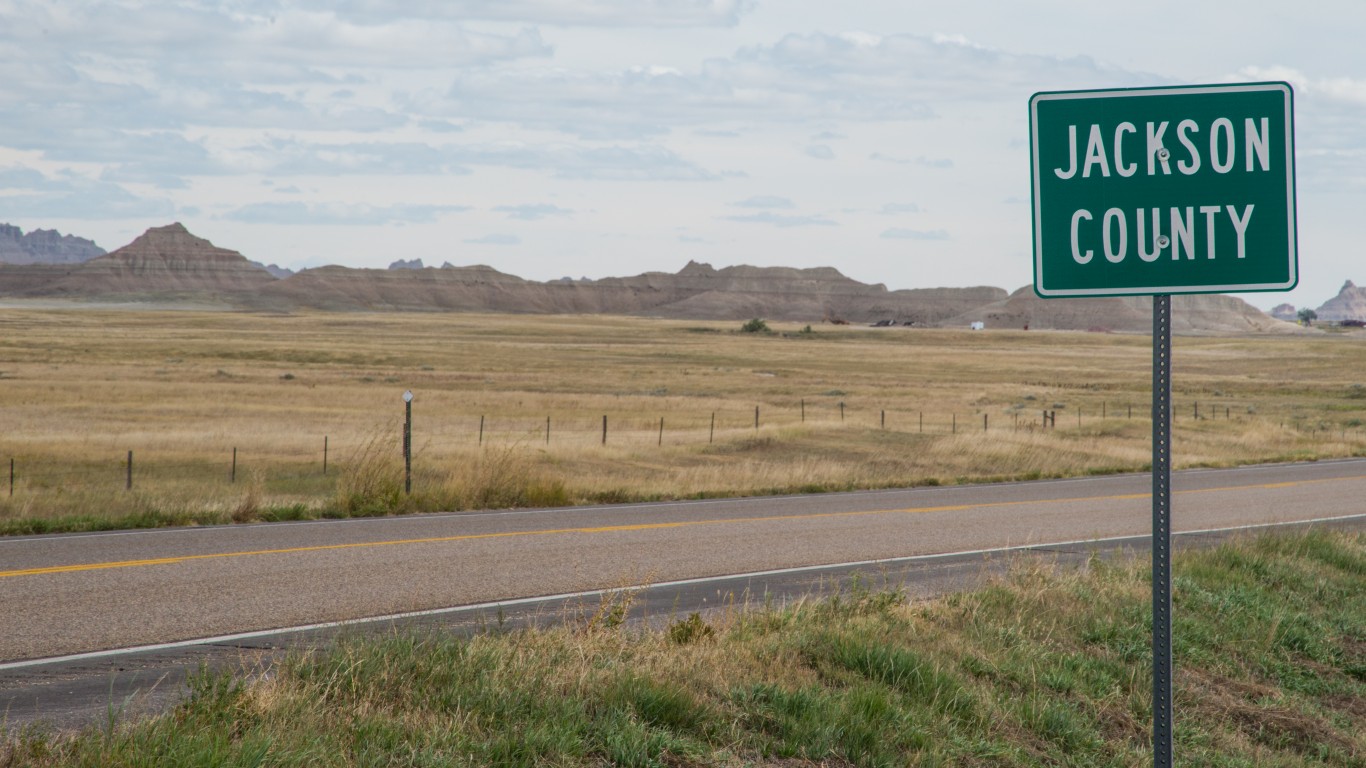
9. Jackson County, South Dakota
> Poverty rate: 45.4%
> Adults with a bachelor’s degree: 17.8%
> Life expectancy at birth: 71.6 years
> Total population: 3,290
> Largest place in county: Kadoka
Covering part of the Pine Ridge Indian Reservation in South Dakota, Jackson County is one of several counties to rank among the worst places to live that encompass tribal territory. Due to a number of historical and contemporary factors, Native American reservations are typically economically depressed areas — and Jackson County is no exception. Over 45% of the local population live below the poverty line, a larger share than in all but three other counties and county equivalents nationwide.
Health outcomes among county residents are worse than they are in much of the rest of the country. This is especially pronounced in some critical measures like average life expectancy, which at just 71.6 years at birth is about eight and a half years below the national average.
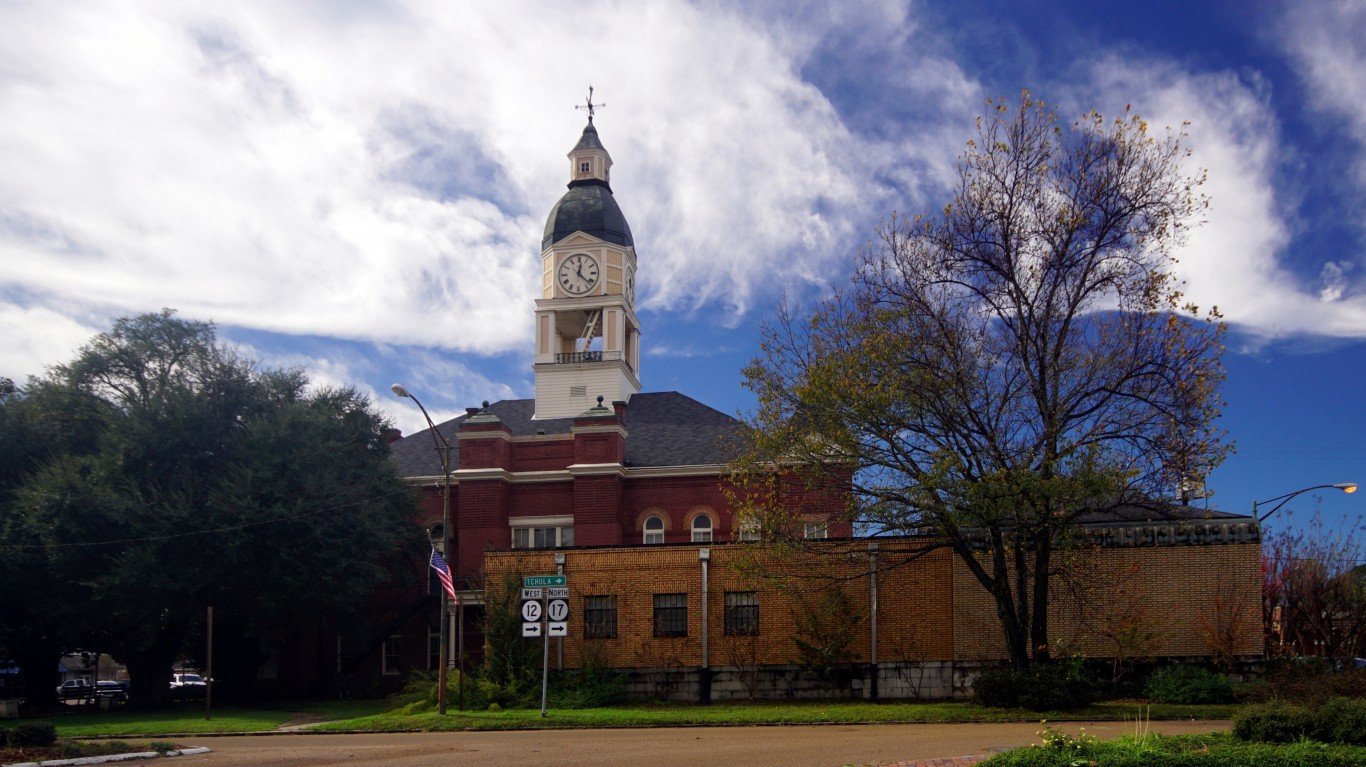
8. Holmes County, Mississippi
> Poverty rate: 42.4%
> Adults with a bachelor’s degree: 10.2%
> Life expectancy at birth: 72.1 years
> Total population: 17,737
> Largest place in county: Durant
Holmes County is located in western Mississippi with the Yazoo River running along its western border and the Big Black River forming its eastern border. Only about one in every 10 adults in the area have a four-year college degree, and only about three out of four adults have completed high school.
Incomes tend to go up with educational attainment, and in Holmes County, many are struggling financially. Some 28.1% of area households live on less than $10,000 a year, and 42.4% of the population live below the poverty line, each among the largest shares of any U.S. county.
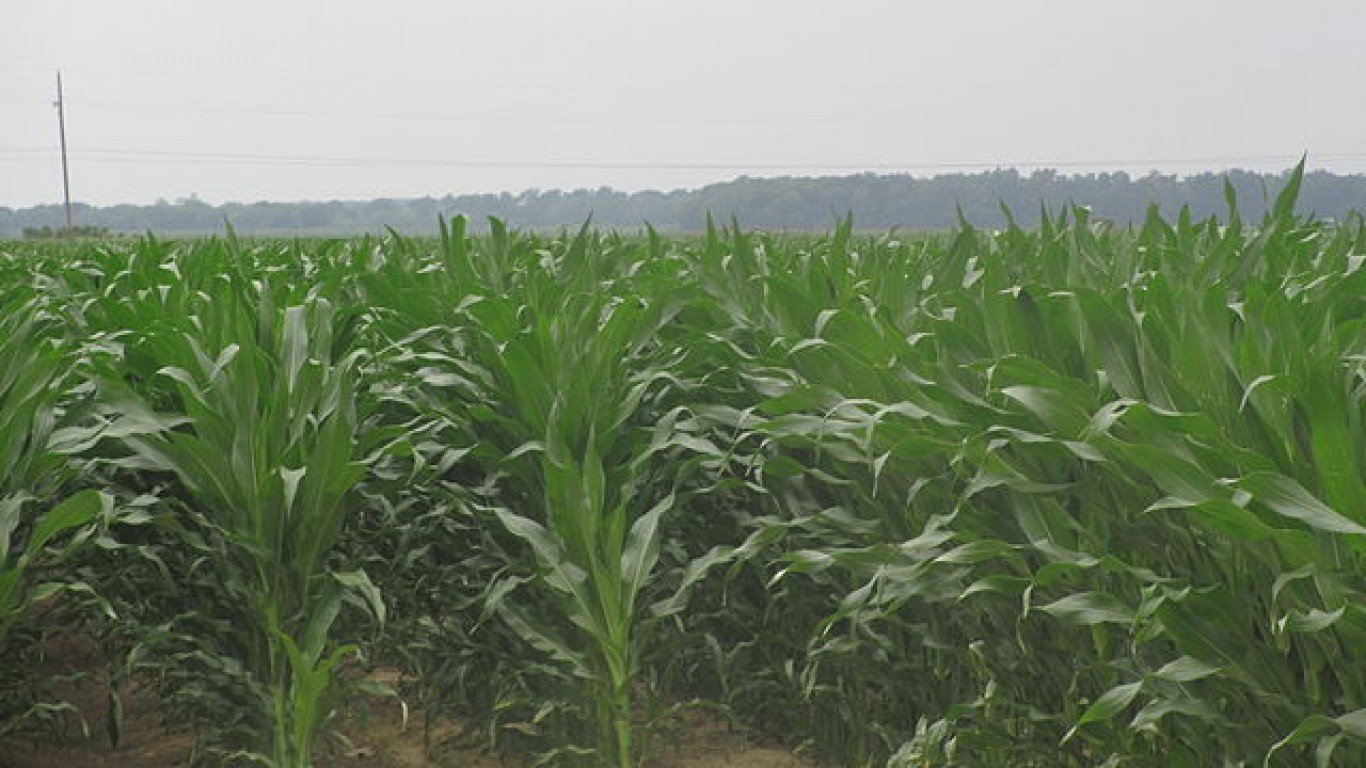
7. East Carroll Parish, Louisiana
> Poverty rate: 44.6%
> Adults with a bachelor’s degree: 8.9%
> Life expectancy at birth: 72.7 years
> Total population: 7,096
> Largest place in parish: Lake Providence
Based on several key measures, East Carroll Parish ranks as the worst place to live in in Louisiana and one of the worst in the United States. This is due in large part to the local poverty rate, which, at 44.6%, is one of the highest of any county or county equivalent in the United States.
Employment opportunities in general are scarce in the area. As of January 2021, 12.5% of the local labor force were unemployed, well above the 6.8% national unemployment rate. Even before the COVID-19 pandemic, the local 2019 unemployment rate stood at 10.6%, well above the comparable 3.7% national rate.
[in-text-ad-2]
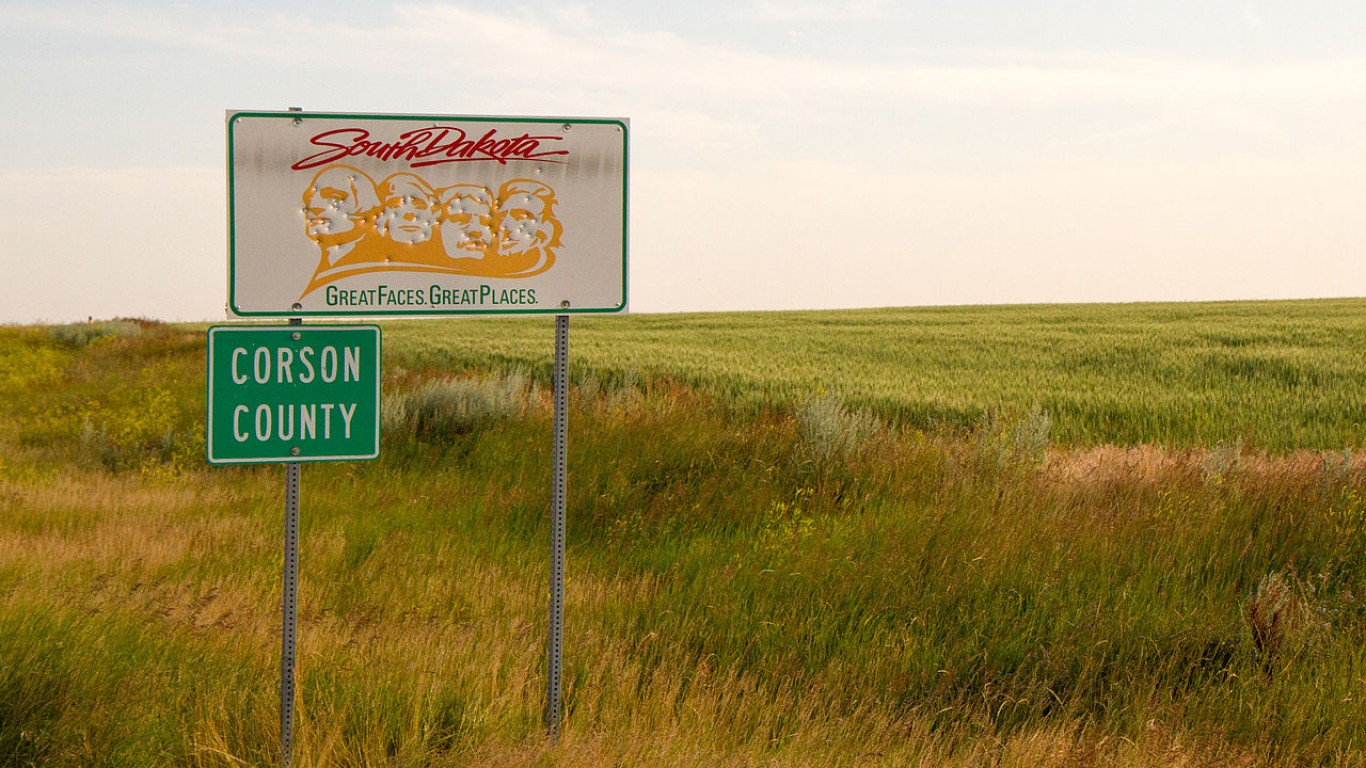
6. Corson County, South Dakota
> Poverty rate: 44.8%
> Adults with a bachelor’s degree: 17.8%
> Life expectancy at birth: 65.7 years
> Total population: 4,150
> Largest place in county: McLaughlin
Corson County covers the South Dakota portion of the Standing Rock Indian Reservation. The self-governed reservation, which was formed in 1889, has some of the worst health outcomes of anywhere in the United States. Area residents are far more likely than most American adults to smoke and be obese and less likely to exercise. Such lifestyles and health factors may help explain the area’s low life expectancy at birth of 65.7 years, which is nearly the lowest of any U.S. county.
Such poor health outcomes tend to be more common in poor parts of the country. In Corson County, 44.8% of residents live below the poverty line, compared to 13.4% of Americans nationwide.

5. Kusilvak Census Area, Alaska
> Poverty rate: 39.0%
> Adults with a bachelor’s degree: 3.9%
> Life expectancy at birth: 68.2 years
> Total population: 8,250
> Largest place in Census area: N/A
The Kusilvak Census Area in western Alaska ranks as one of the worst places to live in the United States, in large part because of low educational attainment. Only 3.9% of adults in the area have a bachelor’s degree, nearly the smallest share of any county or county equivalent nationwide. Adults without a college education are less likely to lead healthy lives compared to those with a postsecondary degree, and in Kusilvak, life expectancy at birth is just 68.2 years, about 11 years below the national average.
Kusilvak is also a poor area. The local poverty rate of 39.0% is nearly triple the 13.4% national poverty rate.
[in-text-ad]
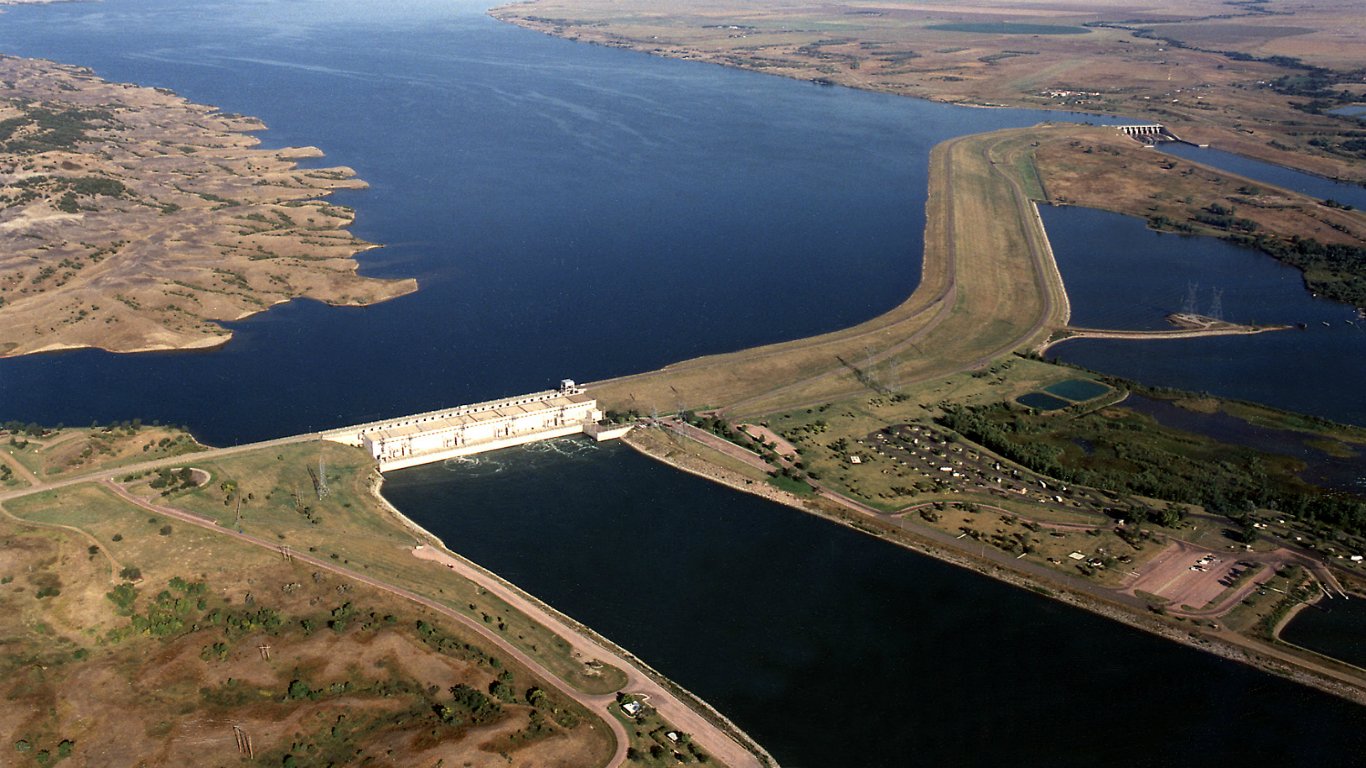
4. Buffalo County, South Dakota
> Poverty rate: 39.7%
> Adults with a bachelor’s degree: 8.5%
> Life expectancy at birth: 61.6 years
> Total population: 2,026
> Largest place in county: Fort Thompson
Buffalo County is located in central South Dakota and covers parts of the Crow Creek Reservation along the Missouri River. Health outcomes on reservations tend to be poorer than in most of the country, and in Buffalo County, life expectancy at birth is just 61.6 years, over 17 years less than the national average and the lowest of any U.S. county.
A low-income area, nearly 23% of households in Buffalo County live on less than $10,000 a year. Additionally, the 39.7% poverty rate in the county is nearly three times higher than the national poverty rate.
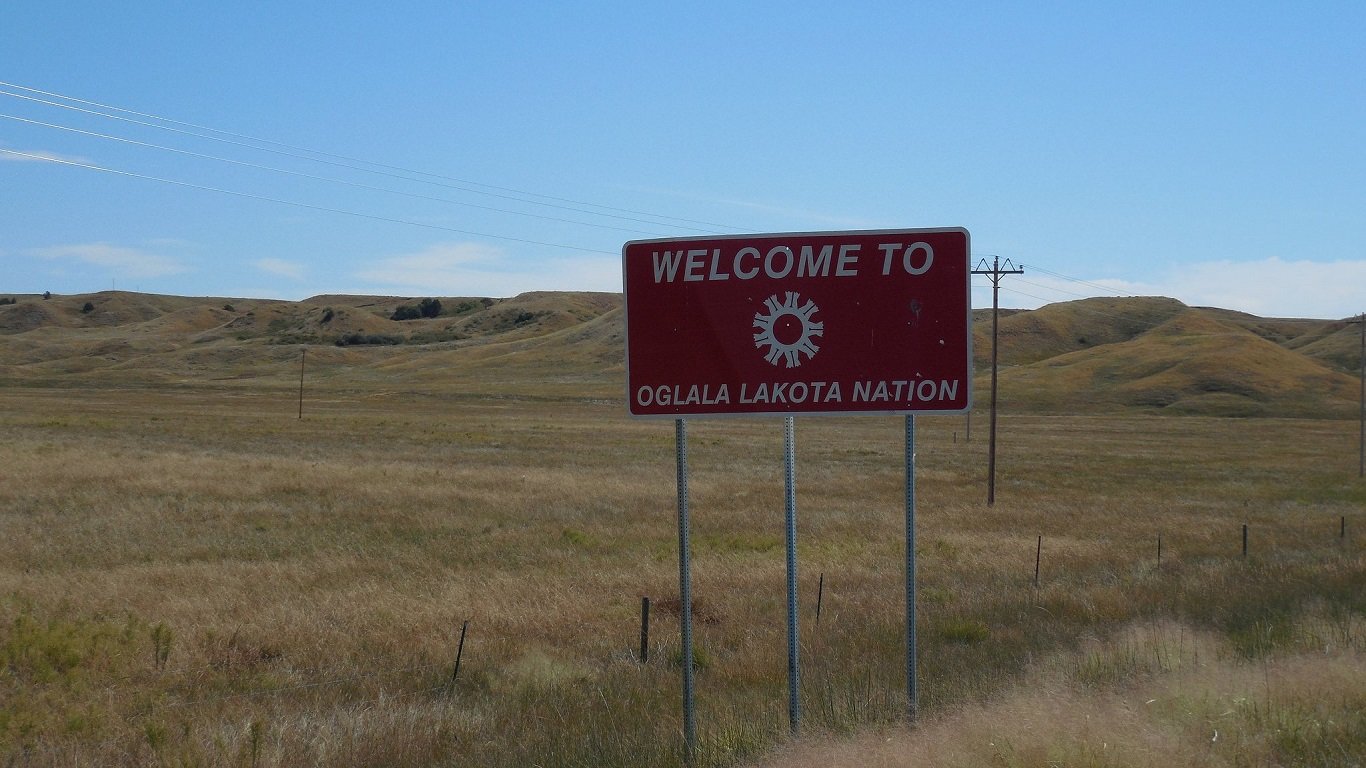
3. Oglala Lakota County, South Dakota
> Poverty rate: 46.2%
> Adults with a bachelor’s degree: 10.4%
> Life expectancy at birth: 62.7 years
> Total population: 14,335
> Largest place in county: N/A
Based on several key socioeconomic measures, Oglala Lakota County, South Dakota, ranks as one of the worst counties to live in the United States. The county covers much of the Pine Ridge Reservation, and is home to one of the most economically marginalized groups in the United States.
In Oglala Lakota County, nearly half of the population live below the poverty line. Poverty is associated with lower poorer health outcomes, and when poverty is coupled with other problems faced in the area such as obesity, high smoking rates, and high drug overdose rates, life expectancy in Oglala Lakota is among the worst nationwide. Life expectancy at birth in the county is just 62.7 years, nearly the lowest of any U.S. county.

2. Mellette County, South Dakota
> Poverty rate: 52.8%
> Adults with a bachelor’s degree: 12.0%
> Life expectancy at birth: 66.7 years
> Total population: 2,052
> Largest place in county: White River
Mellette County, South Dakota, covers part of the Rosebud Indian Reservation, which is among the most economically strained communities in the United States. Native Americans commonly face extreme generational poverty resulting, in part, from their historical mistreatment by the U.S. government coupled with present-day laws, and in Mellette County, 52.8% of residents live below the poverty line.
Low-income areas typically report worse than average health outcomes, and Mellette County is no exception. Over a third of all county residents are obese, and life expectancy at birth is just 66.7 years on average. Dangerous behavior also appears to be relatively common as 66.7% of all driving deaths in the county involve alcohol, more than double the national share.
[in-text-ad-2]
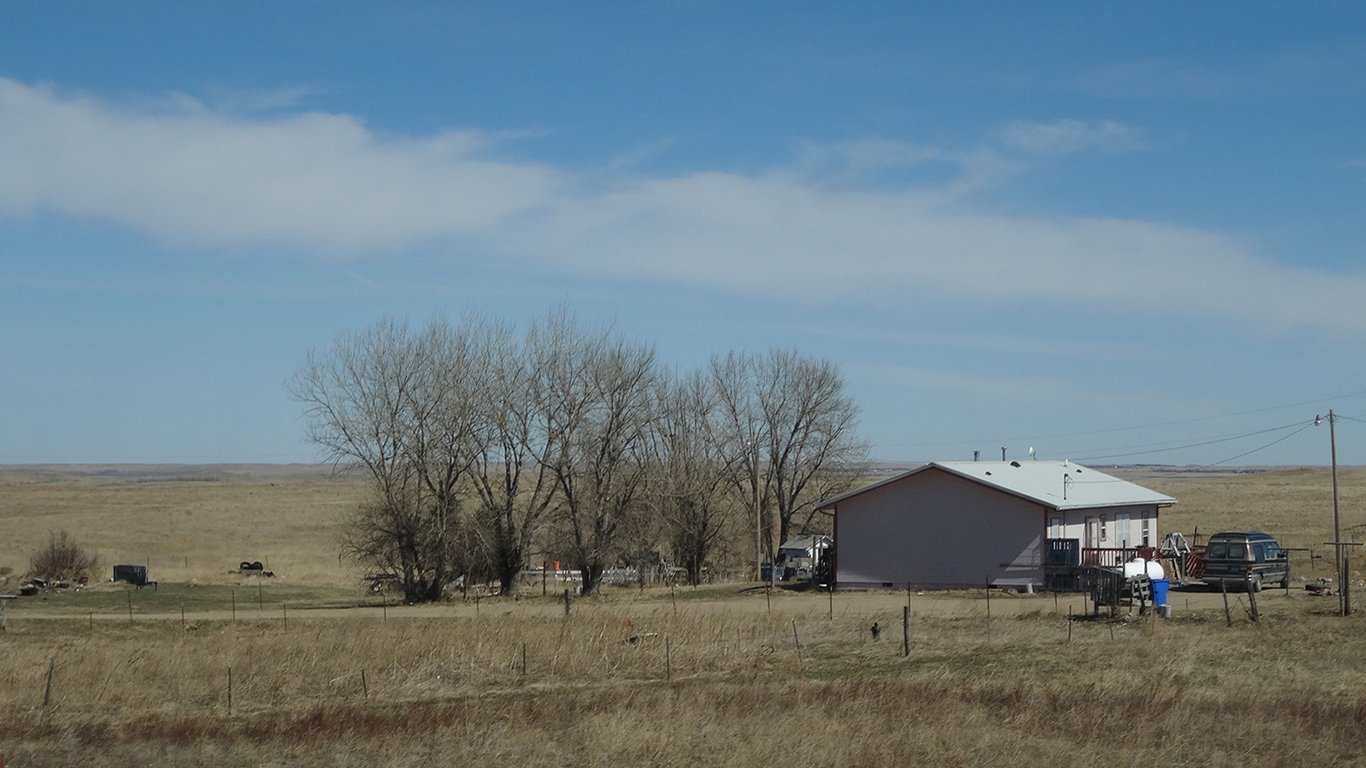
1. Todd County, South Dakota
> Poverty rate: 55.5%
> Adults with a bachelor’s degree: 15.6%
> Life expectancy at birth: 66.7 years
> Total population: 10,195
> Largest place in county: Rosebud
Todd County, South Dakota, which covers part of the Rosebud Indian Reservation along the state’s southern border ranks as the worst place to live in the country — in part because it is the poorest place in the country. Due to a number of historical and contemporary factors, Native American populations are among the most disadvantaged in the United States. An estimated 55.5% of the local population live below the poverty line, more than four times the national poverty rate of 13.4%, and most households in the area earn less than $25,000 a year.
As is the case in most poor areas in the United States, public health outcomes are also below average in Todd County. Life expectancy at birth in the county is just 66.7 years, more than 12 years below the national average. While poverty contributes to poor health outcomes in the area, so do unhealthy behaviors. For example, smoking is the leading cause of preventable death in the United States, and in Todd County, 41.5% of adults smoke, the largest share of any U.S. county.
Methodology:
To determine the worst U.S. counties to live in, 24/7 Wall St. constructed an index of three measures: poverty, bachelor’s degree attainment among adults, and average life expectancy at birth.
Data on the share of individuals living below the poverty line, as well as the share of adults 25 and older with at least a bachelor’s degree came from the 2019 U.S. Census Bureau’s American Community Survey and are five-year estimates.
Data on average life expectancy at birth came from the 2020 County Health Rankings, a joint program of the Robert Wood Johnson Foundation and University of Wisconsin Population Health Institute, and are based on mortality data from the years 2016 to 2018.
Supplemental data on population, income, and median home value are five-year estimates from the ACS. Data on unemployment in January 2021 came from the Bureau of Labor Statistics and are not seasonally adjusted. Data on the number of annual drug deaths per 100,000 residents came from the Centers for Disease Control and Prevention and are for the years 2015 to 2019.
Sponsored: Want to Retire Early? Here’s a Great First Step
Want retirement to come a few years earlier than you’d planned? Or are you ready to retire now, but want an extra set of eyes on your finances?
Now you can speak with up to 3 financial experts in your area for FREE. By simply clicking here you can begin to match with financial professionals who can help you build your plan to retire early. And the best part? The first conversation with them is free.
Click here to match with up to 3 financial pros who would be excited to help you make financial decisions.
Thank you for reading! Have some feedback for us?
Contact the 24/7 Wall St. editorial team.
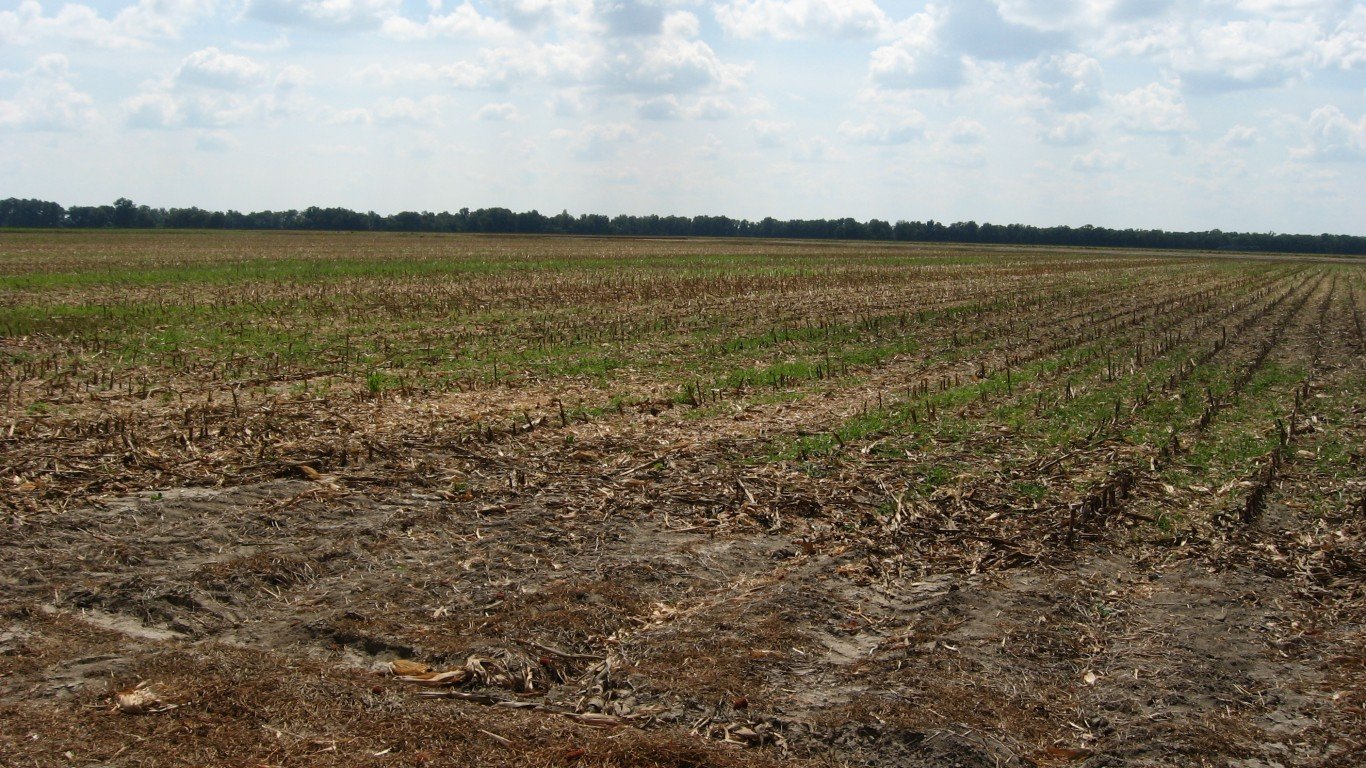
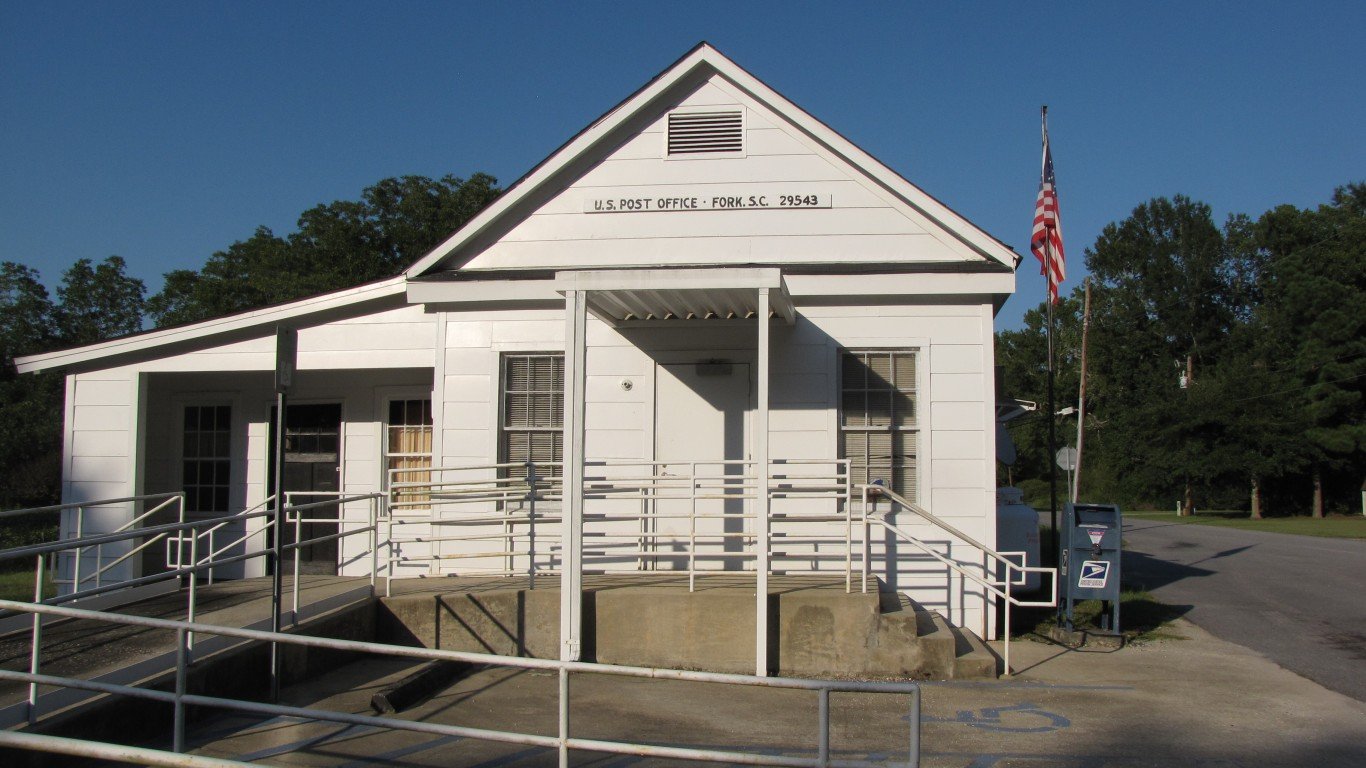
 24/7 Wall St.
24/7 Wall St. 24/7 Wall St.
24/7 Wall St. 24/7 Wall St.
24/7 Wall St.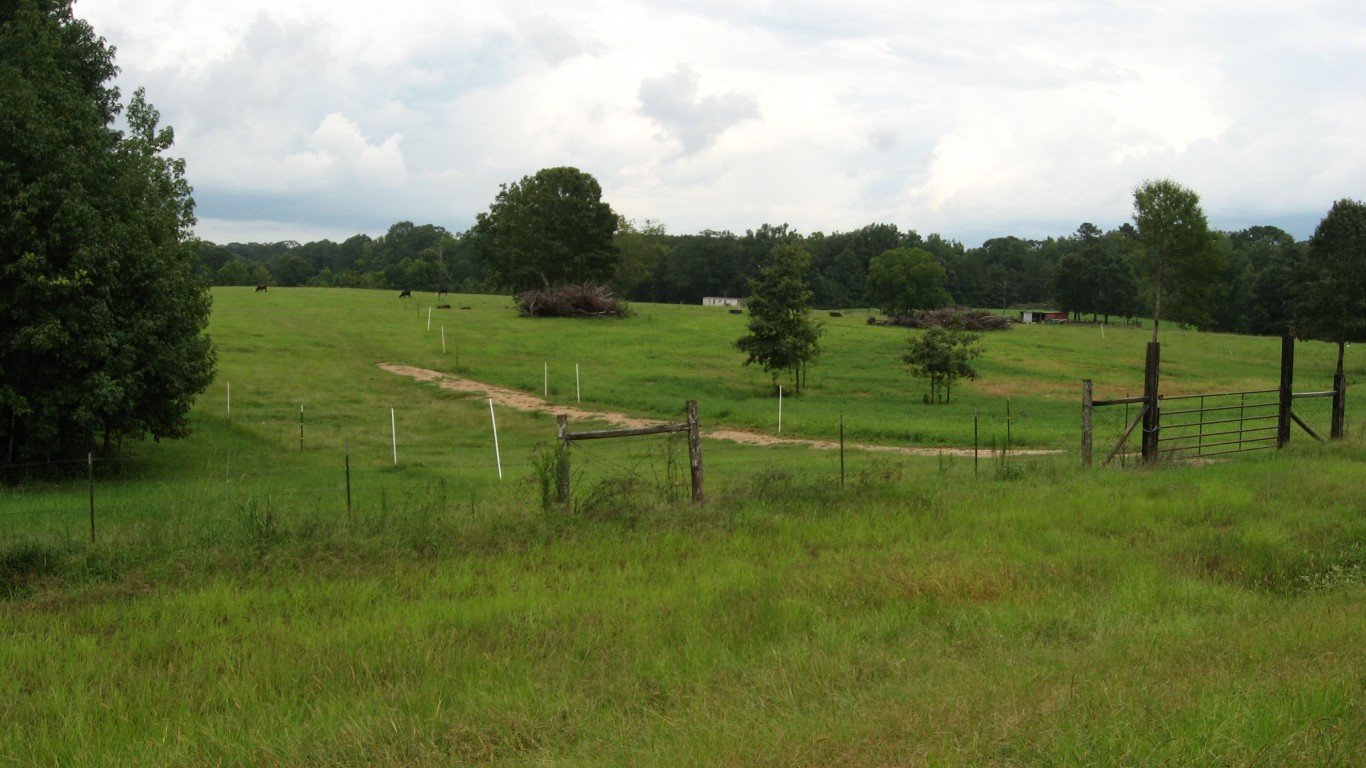
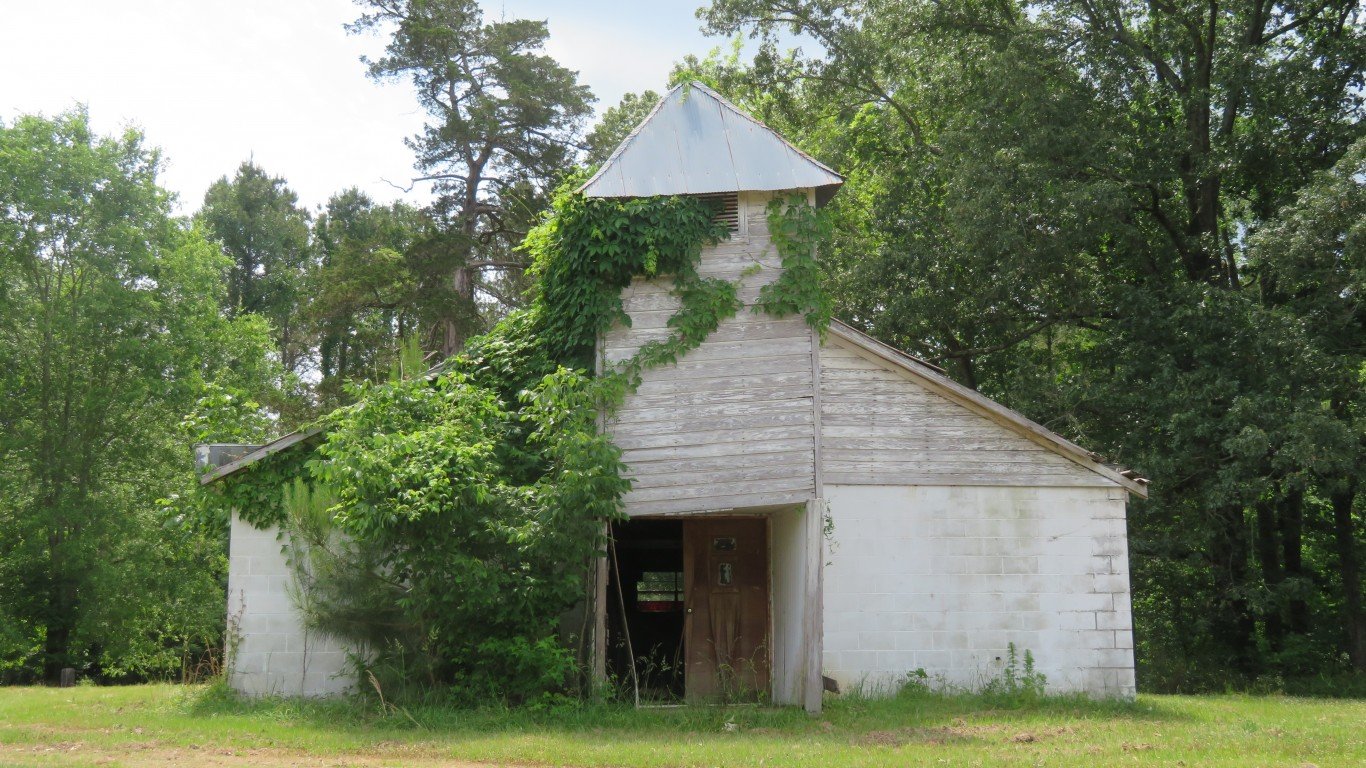
 24/7 Wall St.
24/7 Wall St. 24/7 Wall St.
24/7 Wall St.


